new posts in all blogs
Viewing: Blog Posts Tagged with: Inkygirl Interviews, Most Recent at Top [Help]
Results 1 - 25 of 45
How to use this Page
You are viewing the most recent posts tagged with the words: Inkygirl Interviews in the JacketFlap blog reader. What is a tag? Think of a tag as a keyword or category label. Tags can both help you find posts on JacketFlap.com as well as provide an easy way for you to "remember" and classify posts for later recall. Try adding a tag yourself by clicking "Add a tag" below a post's header. Scroll down through the list of Recent Posts in the left column and click on a post title that sounds interesting. You can view all posts from a specific blog by clicking the Blog name in the right column, or you can click a 'More Posts from this Blog' link in any individual post.

Megan Maynor is a former advertising copywriter and author of picture books ELLA AND PENGUIN STICK TOGETHER and ELLA AND PENGUIN: A PERFECT MATCH (coming 2017), both from HarperCollins Children’s Books. She lives in Minnesota with her husband and three children.
ELLA AND PENGUIN is a new picture book written by Megan Maynor, illustrated by Rosalinde Bonnet, published by HarperCollins Children's Books in January 2016. You can see reviews in Kirkus and Publishers Weekly.
You can find out more about Megan and her work at MeganMaynor.com and on Twitter at @megan_maynor.
Synopsis of ELLA AND PENGUIN:
Ella and Penguin want to see their new glow-in-the-dark stickers glow—but they don't want to go into the dark. (It’s so dark!) Can they see the stickers glow another way? Can they face the dark closet if they stick together?
Q. Could you please take a photo of something in your office and tell us the story behind it?
I got these buttons at the gift shop in the New York Public Library:

The library itself is breathtaking with its marble staircases and wood-paneled reading rooms—all this grandeur for people to read books—for free!
The lions out front are named Patience and Fortitude.
I thought Patience and Fortitude seemed like good guiding stars while navigating the journey to publication.
I looked at these buttons A LOT while writing.
For me, Patience and Fortitude are reminders of the long game. Each day’s progress may be slight, but the only way to get there is incrementally. Likewise, there will be turbulence of all kinds, but the only way to finish is to keep working.
 Megan with a copy of an advance reader's copy of ELLA AND PENGUIN STICK TOGETHER
Megan with a copy of an advance reader's copy of ELLA AND PENGUIN STICK TOGETHER
Q. What advice do you have for young writers?
If you don’t know what to write about, write about your socks. Keep going. You’ll find out what you wanted to write about.
This is advice I got from MY third grade teacher.
And it helped make me unafraid of writing, I think. Will the first thing I write be great? Probably not. And that’s fine. It’s not a big deal where you start. You just start.
When I would get an assignment as an advertising copywriter, and now, when I make up the assignment myself, I can always write something. From there, I just try to make it better and better. How could it be more interesting? More surprising? Funnier or more true? Start with socks. Go from there.
 Jee reading Ella and Penguin Stick Together with his dad, Erik.
Jee reading Ella and Penguin Stick Together with his dad, Erik.
Q. What are you excited about right now?
I’m excited about seeing my book on book store shelves—and in the hands of real live kids!—for the first time. It takes a long time to make a picture book, so this story has lived in my head for years. Now it’s finally OUT THERE, in the world, with real readers.
And it has been an absolute JOY to hear from parents and teachers that their kids are connecting with the story. It’s a bit surreal, to be honest. But so thrilling.
 Mackena loves that there is a narwhal in this book. I do too!
Mackena loves that there is a narwhal in this book. I do too!
------
For more interviews, see my Inkygirl Interview Archive.
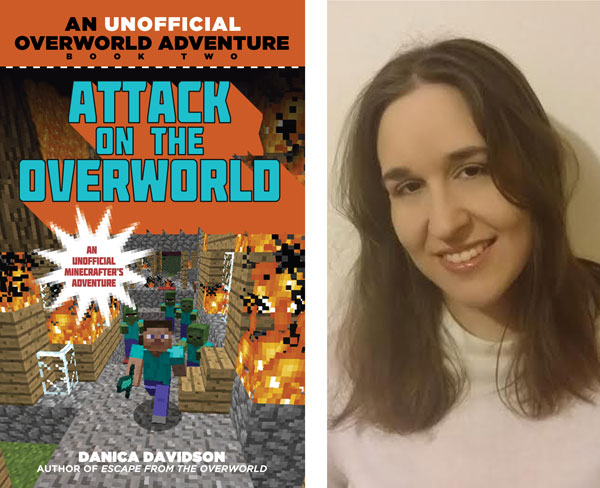
Danica Davidson started writing at age three and never stopped. Before selling her first book, she wrote for such places as MTV, CNN, The Onion and Los Angeles Times. Among other publications, she was recently featured by Forbes for her Minecraft writing. She’s represented by the James Fitzgerald Agency. Attack Of The Overworld is the second book in Danica's Minecraft series, which is geared toward ages 7-12.
Also read Danica's recent post on the BNKids blog about Minecraft, Cyberbullying and Girl Power and her Cynsations interview.
You can find Danica at DanicaDavidson.com and on Twitter at @DanicaDavidson.
Synopsis of ATTACK ON THE OVERWORLD (Skyhorse, 2015): Attack on the Overworld is the sequel to Escape From the Overworld, where Minecraft character Stevie finds a portal to our world and befriends a girl named Maison. Now cyberbullies have hacked the portal and let themselves into the Minecraft world, turning it into eternal night and transforming people into zombies.
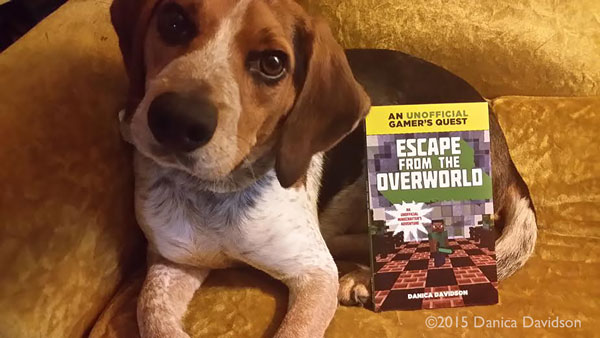
Q. Could you please take a photo of something in your office and tell us the story behind it?
Since I adopted my dog Porthos from the local shelter a couple years ago, he’s been a constant companion.
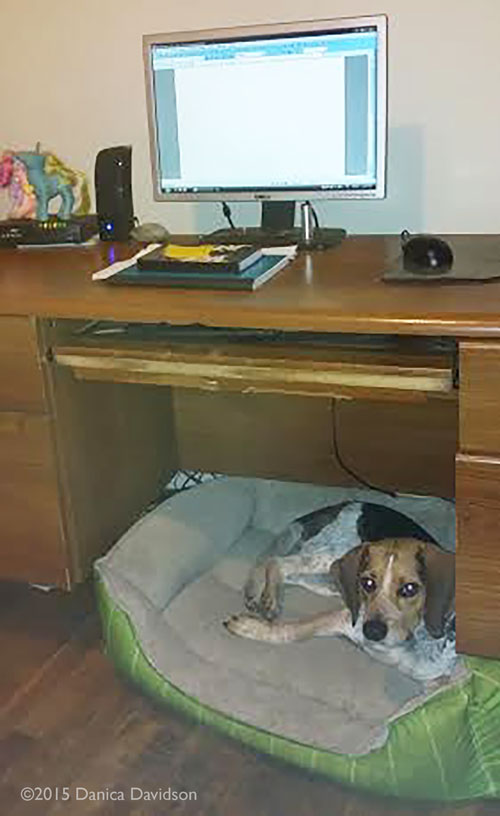
(Bonus points if you get his name reference: he’s named after the beagle Porthos in Star Trek: Enterprise, who in turn is named after Porthos from The Three Musketeers. I know . . . I’m a nerd.) He always wants to be with me, so my boyfriend thought of placing a dog bed under my writing desk. Porthos likes to sleep by my feet while I’m writing and we go out for walks together when I’m brainstorming. I also like to bring him along to book signings of the book store owner says it’s okay. He is the most literary dog I know!
Q. What advice do you have for young writers and/or illustrators?
The most common advice is usually to keep writing/reading/drawing, and I give that, too. But another piece of advice I wish I’d gotten is that it’s normal to get TONS of rejections before you get published, and not only should you not give up, but you should not let it devastate you. Young writers are told to expect rejection, but I was never told to expect as much rejection as I’ve gotten, and sometimes it really got me down.
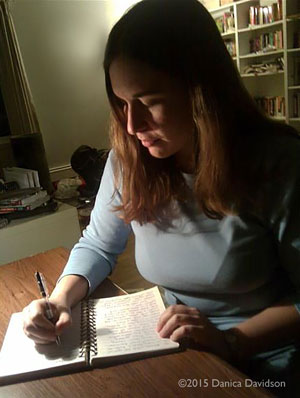 I remember a few years back, when I was swimming in rejection letters, an editor at a magazine told me something along the lines of, “I once met a famous writer who got TEN rejection letters. TEN! So don’t feel so bad.” I was thinking, “I passed ten rejections years and years ago. If ten is the definition of ‘a lot,’ I not only feel bad, but now I feel even worse.” Another writer told me he thought it was time to give up after 35 rejections. Oh, I’d looong passed 35 rejections by then, but I was too embarrassed to say it because I thought he’d tell me to give it up at that point and I couldn’t bear to hear that.
I remember a few years back, when I was swimming in rejection letters, an editor at a magazine told me something along the lines of, “I once met a famous writer who got TEN rejection letters. TEN! So don’t feel so bad.” I was thinking, “I passed ten rejections years and years ago. If ten is the definition of ‘a lot,’ I not only feel bad, but now I feel even worse.” Another writer told me he thought it was time to give up after 35 rejections. Oh, I’d looong passed 35 rejections by then, but I was too embarrassed to say it because I thought he’d tell me to give it up at that point and I couldn’t bear to hear that.
The hardest part is getting your foot in the door. But I kept working, kept networking, kept writing and kept submitting, and in this past year and a half, I’ve sold six books. And I’m ready to write more.
Some people are surprised to see me sell six books while in my twenties, but I tell them I didn’t just start doing this. I’ve been submitting and getting rejected since I was eleven. Ever since I was little I’ve known this is what I wanted to do in my life, and if that’s the case for you, follow that voice with hard work, persistence and a sense of humor.
Q. What are you excited about right now?
I’m excited to see more of my books come out and see where writing takes me next. I have two books out now: Escape from the Overworld and Attack on the Overworld, both Minecraft novels. The third Minecraft novel, The Rise of Herobrine, is out in April. My book Manga Art For Beginners, which teaches how to draw in a manga style, is out in March, and I worked with an amazing artist named Melanie Westin for that one. I've written a graphic novel for a major children's franchise that will be out in the fall. I don’t know how much I can say yet, but there should be a big announcement on that one soon and it’s a franchise everyone knows. And I’m about to get started on my fourth Minecraft book, which will be titled Down Into the Nether, and is scheduled to come out in June. This is what I love to do, and I want to write all different kinds of books for all different ages!
------
For more interviews, see my Inkygirl Interview Archive.

LOUD LULA launches from Two Lions today! Written by Katy Duffield and illustrated by Mike Boldt, LOUD LULA is southern-flavored tall tale about a little girl with a big voice. "...Little ol’ Lula’s big ol’ voice wreaks ten kinds of havoc from the day she’s born, and that doesn’t change one smidgen when Lula starts kindergarten. As you might imagine, Lula’s oversized voice isn’t a great fit for the classroom—or maybe it is…"
See Katy Duffield's answers to my Three Questions.
See Mike Boldt's answers to my Three Questions.
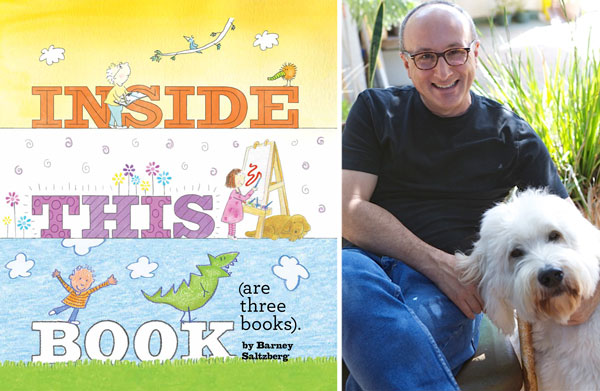
Barney Saltzberg is the author and illustrator of close to 50 books for children, including Beautiful Oops!, Arlo Needs Glasses, Andrew Drew and Drew, and the bestselling Touch and Feel Kisses series with over one million copies in print. Not only that, but he's also recorded four albums of music for young people (!). See the children's concert clip later in this post.
I was lucky enough to meet Barney at ALA earlier this year and more recently discovered his BEAUTIFUL OOPS!...I can't believe I missed this wonderful book before! Those of you who've seen my found object art demos can guess why I fell in love with this book. Do check out Barney's Celebrate Oops! campaign, an initiative designed to build confidence and turn accidents into teaching moments.
You can find out more about Barney and his work at his website, Twitter, Facebook, Instagram, Pinterest and YouTube.
Synopsis of INSIDE THIS BOOK (ARE THREE BOOKS) from Abrams:
"Inside This Book is a tribute to self-publishing in its most pure and endearing form. Three siblings create three books of their own using blank paper that they bind together (in descending sizes to match birth order). One sibling’s work inspires the next, and so on, with each book’s text and art mirroring the distinct interests and abilities of its creator. Upon completion of their works, the siblings put one book inside the other, creating a new book to be read and shared by all!"
Q. Could you please take a photo of something in your office and tell us the story behind it?

I photographed an electric pencil sharpener that my picture book writing teacher extraordinaire, Barbara Bottner gave me when I was working on my very first book which she mentored me through. It mean so much that she believe in me enough to work with me above and beyond, and for her to think enough of my work to give me a pencil sharpener to encourage my drawing. I couldn’t help but add the giant pencil to the photo. It is only fitting. This was a present from my wife and children many years ago. Talk about support and encouragement to dream big! Both of these are important mementos in my studio.
When I was in elementary school, my teachers often sent me home with notes; “Your son has potential, but we don’t know what to do with him.” I am sure that if I were in school now, I would be diagnosed with a number of learning issues. Luckily, I had a teacher, Mr. Maurer, in the fifth grade. He realized I couldn’t spell, (or multiply, or conjugate, etc;) but he recognized that I was a story teller. I wrote a book that was inspired by this years ago called, (Phoebe and the Spelling Bee) Every week, the day before our spelling test, Mr. Maurer would give me the spelling list and have me make up a story on the spot, in front of the class. I never practiced. I winged it every week. I loved the challenge. Looking back at my childhood, I realize that Mr. Mauer found a way to let me shine, in an otherwise, dismal time in an academic setting. He was a truly amazing teacher.
That’s a long winded introduction to my life as an author/illustrator. I find myself standing in front of thousands of students every year as I travel around the world. It never ceases to amaze me that I am being given an opportunity to address children. When I was in school, drilling a hole in the clock with my eyes as I willed it to be 3:00 so I could go home, I never imagined that I would return to so many schools as a published author. (And, love being there!) I always make a point of saying, “For those of you wondering, if you don’t give up, it gets better! I am the poster child for tenacity.” (Then I explain what tenacity means!)
Q. What advice do you have for young writers?
My advice for any writer is to be open. So many of us are certain we have the next ‘big thing’. My story has seventeen sequels. I see it as a movie. If things go right, there could even be a theme park modeled after this book. Dolls, toys, etc. SLOW DOWN. Editors are really smart. Listen to them. I have learned to ‘sleep on it’ for a night (at least) when an editor makes suggestions. This would also go for a critique group as well. Try on the suggestions and see how it feels. I also recommend reading your work out loud while you are proofing things. Also, have someone else read it out loud to you. You will have an opportunity to ‘hear’ your story in a way that is only possible when someone else reads it to you. Also, you know how to read your own stories and it is really helpful to see if the reader gets tripped up or lost or better yet, if they fall in love with your story. That will usually only happen after a million and six re-writes.
Q. What are you excited about right now?
My current book is one I published with Abrams, Appleseed Press called, Inside This Book (Are Three Books). I am a huge Emily Gravett fan and she opened my mind when it comes to the physicality of books. I had done many interactive books like Beautiful Oops and A Little Bit Of Oomph before, but I started adding flaps to some of my picture books as well. Chengdu Could Not, Would Not Fall Asleep, and Andrew Drew and Drew are all picture books with additional flaps. As a musician, I am really aware of the rhythm of a page turn so having the additional flaps in a picture book adds to the way a story unfolds. (Literally and figuratively) Inside This Book (Are Three Books) is a story about three siblings who are given three different sized blank books and how each child creates their own, individual book and what they do with them. Physically, it’s like Russian dolls, with books. I was delighted that Abrams was open to the concept of binding three sequentially smaller books inside of one book. My hope is that this book will help to inspire a whole crop of budding writers and illustrators.
------
For more interviews, see my Inkygirl Interview Archive.
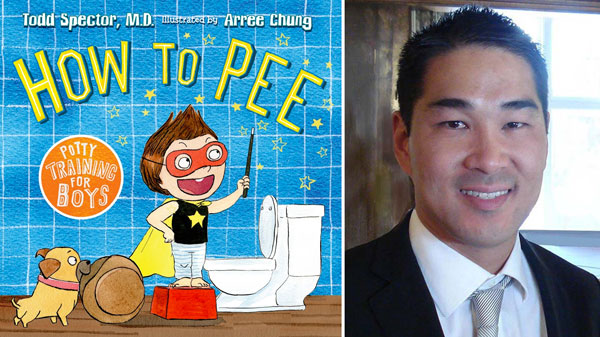
Arree Chung wrote and illustrated the picture book “NINJA!” and is also a founding member of Live in a Story, which offers wall decals created by children's book illustrators and designers. When he's not creating, you can find Arree riding his bike around the San Francisco Bay Area.
Where to find Arree: Website - Facebook - Twitter - Instagram.
Synopsis of How To Pee: Potty Training For Boys (written by Todd Spector, illustrated by Arree Chung, published by MacMillan):
"Out with the old and in with the new! Family physician Dr. Todd Spector presents a fresh and outrageously fun way to encourage little boys to give up their diapers. They can try it freestyle (in the backyard!), or give the potty a try with the help of a few props and plenty of imagination. Peeing in the potty is a lot more fun if you do it rocket style, cowboy style, or superhero style!"
Q. Could you please take a photo of something in your office and tell us the story behind it?
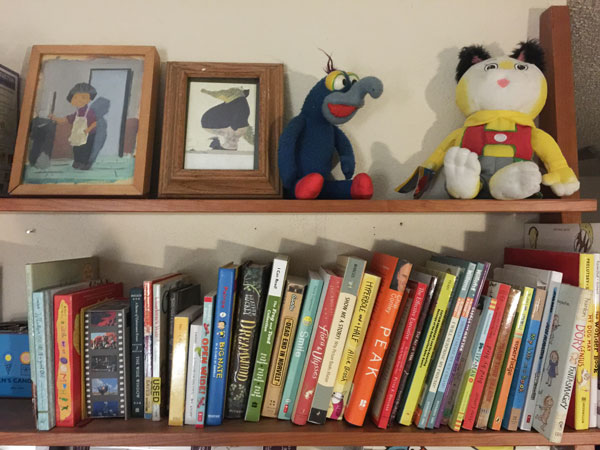
This is one of my favorite toys. Gonzo. This doll is probably older than I am! This doll is special, because Jerry Houle, my licensing mentor gifted this to me. Jerry spent years working with Jim Henson in building a licensing program for the muppets. I am a huge muppets fan and have always admired Jim for his storytelling and the art he has put in the world. Jim changed the way people looked at puppets.
Q. What advice do you have for young writers and illustrators?
As a creative person, the thing I love doing the most is creating something new out of thin air. It maybe a story that becomes a book, a doodle that becomes a painting or an idea that becomes a business.
Making something new can be hard but I find that there are two really hard points: starting and finishing. Here are some tips on how to make it.
GET Excited.
Start right away.
Attack it.
Do it NOW. Get it down.
Scribble. Let yourself go. There is no wrong.
Don’t listen to your inner critic. Listen to your gut instincts. Work fast and intuitively.
Get your first draft done.
Accept that it’s a process. It’s okay that it’s not perfect. You’re making building blocks and you don’t know what pieces you need yet.
Look at the work again. You’ll probably see things you want to change about it. Change it.
Keep working on it. Identify what the heart of your idea is. It should be specific and feel honest.
Now reduce.
Keep reducing until you’re left with just the essentials.
 Sketches for FIX-IT MAN (Author: Susan Hood, Publisher: HarperCollins).
Sketches for FIX-IT MAN (Author: Susan Hood, Publisher: HarperCollins).
Q. What are you excited about right now?
So many things!
Books! I love storytelling. I have three books coming out next year.
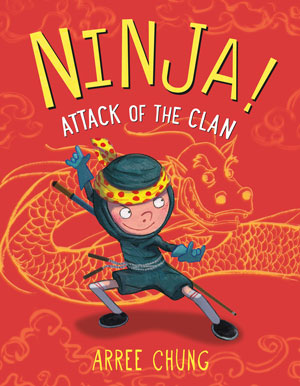
I’m excited about so many things right now. I have three books coming out next year. NINJA! Attack of the Clan (publisher: MacMillan) which is a sequel to my first book, NINJA! I'm illustrating a book called FIX-IT MAN (author: Susan Hood, publisher: HarperCollins), which is about being helpful and inventive. It has a very fun collage style to it. My third book out next year, is HOW TO PEE: Potty Training for Girls (author: Todd Spector, publisher: MacMillan) - which is a sequel to the potty training for boys book I illustrated. I'm really excited about all of the books.
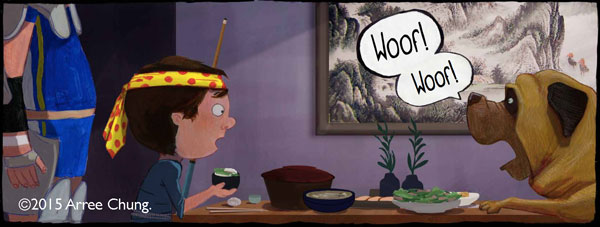
------
For more interviews, see my Inkygirl Interview Archive.
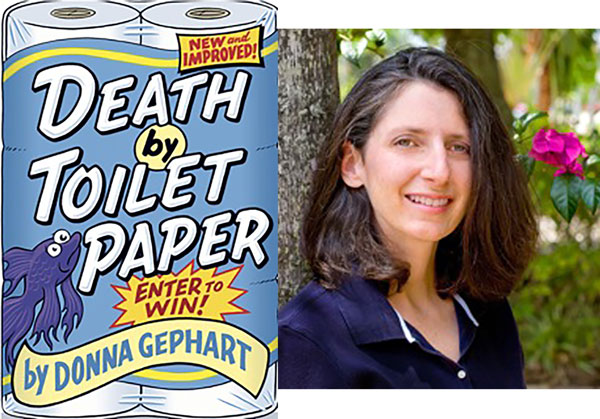
Donna Gephart is a professional nerd. She's written five novels filled with humor and heart for Penguin Random House, including How to Survive Middle School, Death by Toilet Paper and Olivia Bean, Trivia Queen. She's also written some compelling grocery lists and award-winning Post-it notes to her dogs. For free activity/reading guides, lots of fun info and a singing hamster video, visit DonnaGephart.com. "I'm a big fan of teachers and librarians; let's connect @Dgephartwrites or via carrier pigeon -- whichever is more convenient and poops less."
I first met Donna when she wrote for me at Inklings, my email newsletter for writers back in the early days of the Web. As I prepped her Three Questions interview, I looked back through some of my old archives and found a "Writing Funny For Money" piece she did for me back in 1998(!).
Synopsis of DEATH BY TOILET PAPER:
When the good toilet paper is replaced by cheap, scratchy stuff, Benjamin Epstein realizes his hard-working mom is in deep financial trouble. Ben will do anything (entering contests, selling candy bars, etc.) to help his mom pay the rent and keep a promise he made to his late father. (Toilet and toilet paper trivia head each chapter.) Nominated for Pennsylvania, Maine and Rhode Island state reading lists and winner of the Sydney Taylor Honor Award.
1. Could you please take a photo of something in your office and tell us the story behind it?

My friend's daughter creates sculptures of each of my book's characters. Hammy the Hamster from How to Survive Middle School w/his microphone to the right. And Vanessa Rothrock from As If Being 12-3/4 Isn't Bad Enough, My Mother Is Running for President on the left. You might notice Vanessa has no pants (nor legs).
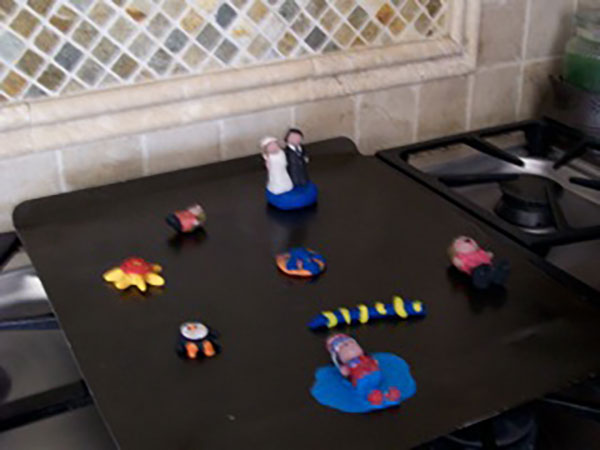
They melted on the cookie sheet in my friend's oven because her daughter ran out of clay and used a cheap substitute for the legs. We now refer to her as Vanessa Meltypants.
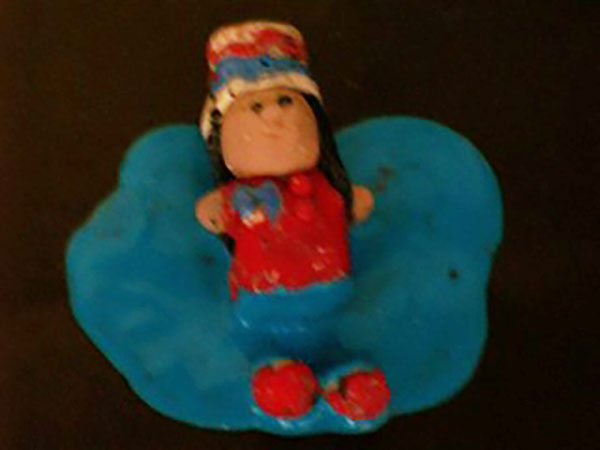
Our one dog keeps me company every day while I write, while the other dog guards the front window by barking at dangers, such as the UPS delivery person, babies being pushed in strollers and the bunny who sometimes hangs out on our lawn. (Our window blinds will never be the same.)
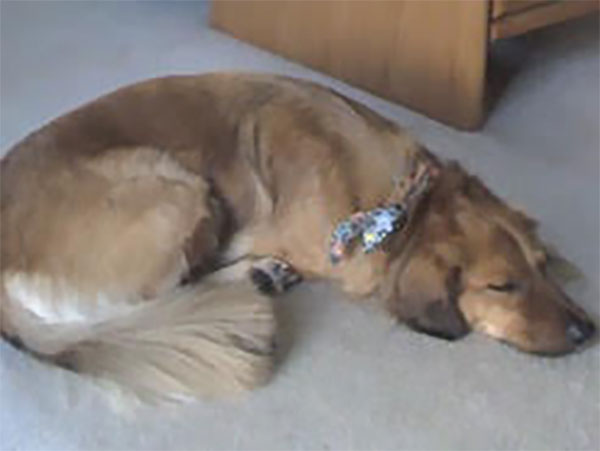
2. What advice do you have for young writers?
There's some advice on my site from industry professionals and resources for young (and young at heart) writers:
Everyone says: "Write what you know." But I think if you write only what you know, it would be boring. Write what you'd like to know. I purposely create ideas for my novels that require me to research and learn new things. Did you know there are 516,000 bacteria in every square inch of armpit? Your brain weighs about three pounds? And the first stall in a public bathroom is the least used and therefore the cleanest? (You're welcome for that last one.)
Write the emotional truth of what you know. Do you know what it's like to feel lonely, scared, left out, overjoyed? Write about those feelings!
You may not believe this, but the bliss in writing is in the actual writing -- in losing oneself completely in the process of creating something that didn't exist before -- not in the outside rewards one might get from being published, winning an award, etc. Although those things are nice, too. Let everything else go and write with great joy . . . and a pen. A pen definitely helps.
3. What are you excited about right now?
I'm excited to have a wonderful year of school visits, Skype visits and book festivals behind me and a long, lovely summer ahead to daydream, fill up on books and play outside with friends, family and our dogs.
And write.
------
For more interviews, see my Inkygirl Interview Archive.
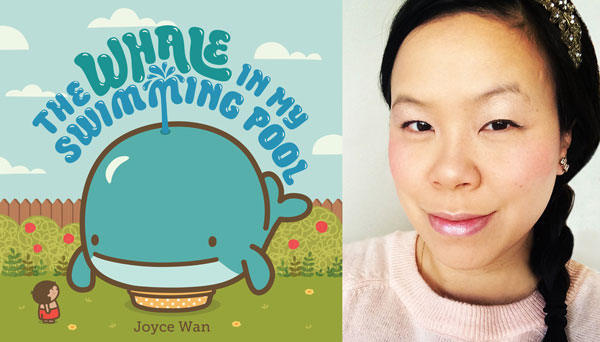
Joyce Wan designed her first greeting card when she was in first grade for a city-wide greeting card design contest. The design won first place and was subsequently sold through a major department store chain. Twenty years later that design would inspire a design studio called Wanart whose products and books featuring Joyce's art are now sold world wide.
I first met Joyce at the SCBWI Summer Convention in Los Angeles, before I got my first children's book contract, and I so appreciated how welcoming and encouraging she was when I was such a nervous newbie.
You can find Joyce on Wanart.com, Facebook, Twitter and Instagram.
Synopsis for THE WHALE IN MY SWIMMING POOL (Farrar, Straus and Giroux, 2015):
One sunny day, a little boy heads outside for a swim, but his pool is already taken. There’s a big whale in the water and it’s not budging! The boy tries everything to get the whale to leave. Nothing seems to work. Not fetch. Not tag. Not even offering his allowance. What’s a boy to do? A picture book about a boy who makes the best of an unusual situation. This colorful whale of a tale from the talented Joyce Wan is sure to inspire giggles from little guppies!
1. Could you please take a photo of something in your office and tell us the story behind it?
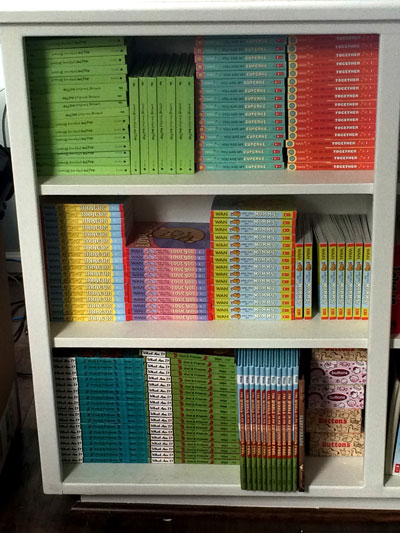
This is the shelf in my studio containing all the copies of my published books that I use for promotional purposes. I’m still amazed that my first book only came out in 2009. Now, 6 years later, there are 10 different books on that shelf with several more to come in the coming years. The road to getting published can be a long, hard one but once the ball gets rolling, a lot can happen in a short amount of time (I’m sure you can relate Debbie!). I feel blessed every time I look at this shelf.
2. What advice do you have for young writers and illustrators?
Keep a sketchbook or notebook with you at all times to jot down all your ideas. No ideas are too silly or simple. I did not submit my book YOU ARE MY CUPCAKE to publishers until a year after developing the concept. I kept worrying that the idea was maybe too simple. It has since gone on to sell over a couple hundred thousand copies and has turned into a whole line of board books with Scholastic. I often wonder how many wonderful ideas never see the light of day because the creators themselves didn’t give it a chance.
Another tip is to set regular, realistic deadlines for yourself. (ie: complete one drawing/painting every week or complete a rough draft of a story every month, etc.) I am a self-trained illustrator but I started my illustration career with my own greeting card business. What helped me develop a style and improve my drawing skills was I would set regular deadlines for myself (ie: 12 greeting cards every month). Not only did my drawing skills improve but I was able to make the overwhelming task of creating an entire greeting card collection seem more feasible.
I think creative people often feel overwhelmed and paralyzed by self-doubt and the emptiness of a blank page. THINK BIG, ACT SMALL, but ACT nonetheless-ONE STEP AT A TIME towards your goals.
3. What are you excited about right now?
I’m excited about wrapping up a few illustration projects including a new picture book series called PEEP & EGG by Laura Gehl and PUG MEETS PIG by Sue Gallion so that I can switch gears and get back into some of my own author/illustrator projects. The best thing about my job is that no two days are the same.
------
For more interviews, see my Inkygirl Interview Archive.
Also see Donalyn Miller's Summer Book-A-Day Challenge | Archives of my #BookADay posts.
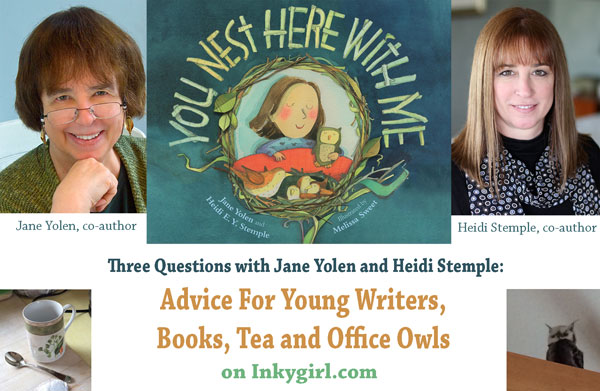
Today, I'm delighted to have Jane Yolen and Heidi Stemple visiting Inkygirl. Jane and Heidi are not only a mother-daughter writing team but also co-authors of YOU NEST HERE WITH ME, a new picture book that recently came out from Boyds Mill Press, illustrated by Melissa Sweet. I've also been a longtime fan of Jane's work, especially her fairy tale retellings.
I asked both Jane and Heidi to answer Three Questions for me, and here are their answers:
Three Questions With Jane Yolen
Three Questions With Heidi Stemple
For Part 1 of my YOU NEST HERE WITH ME series, please see Three Questions With Heidi Stemple.
 Photo: Jason Stemple.
Photo: Jason Stemple.
I was thrilled to meet Jane Yolen at a recent SCBWI conference, and even more excited when Jane read my f&g of Where Are My Books? and liked it (see photo at the very end of this interview). Jane Yolen is the renowned author of many children's books, fantasy, and science fiction, including Owl Moon, The Devil's Arithmetic, and How Do Dinosaurs Say Goodnight? Her books, poems and stories have won many awards, including the Caldecott Medal.
You can find Jane at her website, JaneYolen.com, on Facebook and on Twitter. She and her daughter Heidi Stemple run a Picture Book Boot Camp (next one is Sept. 10-13, 2015), which is a Master Class in her home:

Her newest book is YOU NEST HERE WITH ME, a picture book co-written with Heidi Stemple (see Heidi's Three Questions interview in Inkygirl.com earlier today) and illustrated by Melissa Sweet, published by Boyds Mill Press in March 2015.
Synopsis of YOU NEST HERE WITH ME:
This lyrical bedtime book is an ode to baby birds everywhere and to sleepy children, home safe in their own beds. As a mother describes how different species of birds nest, secure and cozy with their mama birds, she tucks her own child into bed with the soothing refrain, “you nest here with me”—easing her little one and readers alike to slumber. Perfect for a young audience, this poetic text begs to be read aloud, and is accompanied by Melissa Sweet’s incredibly warm and original art.
Q. Could you please take a photo of something in your office and tell us the story behind it?
 Photo: Heidi Stemple.
Photo: Heidi Stemple.
Like most writers, I have an enormous research library in my home and when I am working on a particular project, those books get scattered around my writing room.

As I am currently working on two very different manuscripts--one set in the Holocaust (the first section in the Lodz Ghetto) and the other a graphic novel trilogy set in 1930s Edinburgh, I chose to pick out a book from each of those piles to feature in the photograph. At the top is a day-by-day catalog of what happened during the ghetto years in Lodz, and in the second materials about Scotland through the ages. Fiction has to take the real and massage it into a story that nay (or may not) have actually happened. We recreate (hi)story and bring our readers along.
 Photo: Heidi Stemple.
Photo: Heidi Stemple.
From Jane, about the photo above: "I can't seem to write without a cup of tea (British decaf with demarara sugar and a splash of Lactaid milk.) I keep making cuppas coming all day long."
Q. What advice do you have for young writers?
Read, read, read.
Write something every day.
Never take no for an answer.
Don't believe your reviews--either good or bad.
Heart on the page.
Know that books are not just written, but rewritten.
(Above: Listen as Jane reads and critiques her very first poem)
Q. What are you excited about right now?

Two of my old books recently splashed out big: HOW DO DINOSAURS GET WELL SOON (Scholastic) won the Colorado One Book Award, and BAD GIRLS (Charlesbridge)--written with daughter Heidi Stemple--won the Magnolia Award, Mississippi's Children's Book Award for the middle grades. Plus the latest book Heidi and I just published--YOU NEST HERE WITH ME (Boyds Mills) with amazing illustrations by Melissa Sweet--has recently had a tremendous start and after only a month is getting a second printing.
But honestly, I am always most excited about the manuscript I am working on now. That's where my heart is, where my soul is. That is where my tomorrow is.

------
For more interviews, see my Inkygirl Interview Archive.
For Part 2 of the YOU NEST HERE WITH ME series, please see Three Questions With Jane Yolen.

Heidi Stemple didn’t want to be a writer when she grew up. In fact, after she graduated from college, she became a probation officer in Florida. It wasn’t until she was 28 years old that she gave in and joined the family business, publishing her first short story in a book called Famous Writers and Their Kids Write Spooky Stories. The famous writer was her mom, author Jane Yolen. Since then, she has published twenty books and numerous short stories and poems, mostly for children.
I had a chance to hang out with Heidi at the SCBWI Summer Conference last year. She's smart, she's funny and she's so supportive of others in the industry. Then partway through a group conversation, I also discovered that her mom is Jane Yolen (!!).
Heidi and Jane run a Picture Book Boot Camp (next one is Sept. 10-13, 2015), which is a Master Class in Jane's home:

Where to find out more about Heidi:
Heidi's website - Twitter - Heidi's Author Page on Facebook - Facebook page about the yearly owl count
Synopsis of You Nest Here With Me (Boyds Mill Press, 2015):
This rhyming bedtime book is part lullaby and part introductory field guide for the smallest ornithologists. But, at its heart, it reminds baby birds and children alike that home is wherever you are safely tucked in with your family. If you look in the back of You Nest Here With Me , you'll see that part of the dedication is to The Cornell Lab of Ornithology. If you want to know more about birds--including listening to owl calls, visit them at: http://www.birds.cornell.edu/Page.aspx?pid=1478.
 Heidi's office. (The cat is named Romeo)
Heidi's office. (The cat is named Romeo)
Q. Could you please take a photo of something in your office and tell us the story behind it?
I love birds. All birds. But, especially owls.
 "Think I'm kidding about the owls? I even have owl nesting dolls."
"Think I'm kidding about the owls? I even have owl nesting dolls."
I have about a hundred owls in my house. Actually, I’ve never counted them, but there are a lot.
 Heidi's living room. "See the owl in the rafters? His name is Wilbur and he watches out over the house." My mother, author Jane Yolen, wrote a book you might know called Owl Moon. It’s about a little girl who goes out owling with her dad. What you may not know is that the little girl is me and Pa is my father, David Stemple, who was a great owler. He was the one who taught me to call owls and now, once a year, I lead a team of owlers for the Audubon Christmas Bird Count. On our best year (so far) we called down 67 owls from midnight to 7am.
Heidi's living room. "See the owl in the rafters? His name is Wilbur and he watches out over the house." My mother, author Jane Yolen, wrote a book you might know called Owl Moon. It’s about a little girl who goes out owling with her dad. What you may not know is that the little girl is me and Pa is my father, David Stemple, who was a great owler. He was the one who taught me to call owls and now, once a year, I lead a team of owlers for the Audubon Christmas Bird Count. On our best year (so far) we called down 67 owls from midnight to 7am.

These (pictured above) are probably my favorite owls—they make up a bookend that my dad had in his office. Now they sit on the bookshelf right next to my desk and remind me of him.
Q. What advice do you have for young writers?
When you live in a family of writers (my mother and both my brothers work in children’s books) you know that inspiration comes from everywhere. You never know when and from where an idea for a story will pop up. Keep your eyes, ears, and mind open at all times for those ideas. And, write them down because ideas are slippery little buggers.
 Prep for the Owl Count
Prep for the Owl Count
Every writer has all sorts of notes jotted all over the place with ideas for stories or poems or essays or speeches. I even have the beginning of a story on my iphone—you can’t really understand it because I dictated it with voice-to-text and it got most of the words wrong. But, it’s good enough for me to figure it out later when I am ready to write that story.
Q. What are you excited about right now?
I am always excited about my newest book and the book (or usually books) I am working on. So, besides the projects I am writing and researching right now (which involve pirates, the civil war, the Christmas Bird Count, cookies, the moon, monsters, and soup—yes soup) I am probably MOST excited about my brand new book You Nest Here With Me (co-authored by Jane Yolen and illustrated by Melissa Sweet). This is a book that took 12 years to get published. We sold it twice—to the same editor at 2 different publishing companies—and then waited 3 years for the illustrations. I am glad we were patient because we are so happy with the way it turned out.
------
For more interviews, see my Inkygirl Interview Archive.

Christopher Cheng is an award-winning Australian author of more than 40 children's books and is a co-chair of the International Advisory Board for the SCBWI. I met Chris through the SCBWI, and I love his enthusiasm and positive energy. Pictured above: Chris with a python (!) as well as his narrative non-fiction picture book, PYTHON. Python was written by Chris, illustrated by Mark Jackson, and was published by Candlewick; it was shortlisted in the 2013 Children's Book Council Of The Year awards.
You can find more info about Chris at his website, Facebook, Twitter, Google+ and YouTube.
Synopsis of PYTHON:
Python stirs and slithers out from her shelter, smelling the air with her forked tongue. It’s time to molt her dull scales and reveal the glistening snake underneath. Gliding along a tree, she stops and watches very, very closely as a bird drops onto a branch — and escapes the razor-sharp teeth just in time. But Python is hungry, so she slides on to stalk new prey. Combining informative facts, expressive illustrations, and a lyrical, mesmerizing narrative, here is a book to captivate anyone fascinated by this iconic creature.
Q. Could you please take a photo of something in your office and tell us the story behind it?
A photo of SOMETHING in my office - was that SOMETHING or ONEthing or ANYthing? Well, because I am never good at following instructions (can you write the manuscript to 35000 words - sure … and then I submit a 55000 word manuscript that was published), I just have to send you two.
First, my CHOP!

This is me (as you can tell from the side … but there is also actually my Chinese name on the base that I use to ‘chop’ my books when I am signing them at home.

If I am travelling, I have a mini version of this - it's my travelling chop! and then here is the photo of the creatures bordering my desk … I lurve having these:

Q. What advice do you have for young writers?
Five letters, sounds like LIGHT …. WRITE!
Do it every day.
Do it for fun -
WRITE anything that comes in to your head;
WRITE what you heard your big sister say on the telephone last night when she thought she was speaking in secret;
WRITE what you wish to do;
WRITE what you want to do;
WRITE what your IMAGINATION tells you to write.
just WRITE.
And when you write, edit what you write … don’t make it a ramble (unless it is supposed to be). Sometimes later (it might be after your initial thoughts, it might be after a day or so - on the day you set aside as the reviewing day) go back and rewrite your work. Write about what makes you happy. Write about what makes you sad. Write about … what you are too afraid to write about!
And when you write, giggle and laugh and cry and moan and weep and slobber … get into the skin of your character. BE your character. Ask the questions what would (your character) do?
And ENJOY what you are doing.

Q What are you excited about right now?
Joining the throng of folk that Debbie is interviewing.
Life … I love hanging out with others of my kind - children’s book people.
Reading new books by my friends - like Samantha Berger, and Debbie Ridpath Ohi, and Isabel Roxas and … and SCBWI - we are a beautiful tribe.

------
For more interviews, see my Inkygirl Interview Archive.

Jodi Moore is author of WHEN A DRAGON MOVES IN (illustrator: Howard McWilliam, published by Flashlight Press), the upcoming sequel WHEN A DRAGON MOVES IN AGAIN (launching Sept/2015) and GOOD NEWS NELSON (illustrated by Brendan Flannelly-King, published by Story Pie Press). The proud mother of two grown sons, she lives in Pennsylvania with her husband and an ever-changing bunch of characters in her head. You can find out more about Jodi and her work at WriterJodiMoore.com, her blog, Facebook and Twitter.
I love Jodi's cheer and enthusiasm in person as well as online, and she's always been so supportive of her fellow children's/YA book writers. Thanks to Jodi for answering my Three Questions today!
Trailer for WHEN A DRAGON MOVES IN:
Synopsis of WHEN A DRAGON MOVES IN AGAIN:
If you build a perfect castle, a dragon will move in, followed by... a baby?! Hilarity ensues as the trio bonds, until the baby charms the dragon away. Is there room in the castle for three? Decide for yourself WHEN A DRAGON MOVES IN AGAIN, sequel to the award-winning WHEN A DRAGON MOVES IN.
THREE QUESTIONS FOR JODI MOORE:
1. Could you please take a photo of something in your office and tell us the story behind it?
Okay, truth? My office looks like something out of the Hoarders reality show. It’s piled high with books, papers, printed-out manuscripts, pictures of my kids, stuffed animals and other assorted knick-knacks, plaques with motivational quotes, a chocolate bar (or three)…and, oh, yeah – somewhere amidst all of my “inspiration”, there’s a desk with a computer on it.
Each thing inspires, grounds or nourishes me in some way. Picking one has proven to be an impossible task…so with your kind permission, may I offer a few?
You see, while it’s hard for me to choose that “something”, choosing the “someone”s is not. I would be nowhere without the support and encouragement of my family. And while I always broaden that to include my extended family, creative friends, crit partners, booksellers, teachers, librarians, readers and the entire kidlit community, I would never have had the courage or belief in myself to take that first step in pursuing my dream had it not been for my husband and two sons.
I thought about sharing their pictures – or gifts they’ve purchased to help motivate me – but I realized nothing touches my heart more than what comes from theirs:

These notes from my husband are the first things I read every morning. Knowing he believes in me helps me to believe in myself. Larry not only loves and supports me, he “gets” me. (Oh, and if you haven’t figured it out, Lady & the Tramp was the first movie he took me to. Thirty-five years later, we still refer to each other as such.) The witch? A little token from him as well. When I was a child, the Wicked Witch of the West scared the heck out of me. I was fortunate to play the role in community theatre years ago, allowing me to conquer those fears. Now the witch and I are buds.

The middle picture is a painting our son Steven created when he was about eight years old. I once read a book where the author alleged that if you ask a very young child to describe heaven and the “all-mighty” spirit (whichever religion or belief system you choose), they can and will. Their memories are still fresh, she proposed, although sadly fade with time. Even as a toddler, “Stevie” was always introspective and deep – seemingly an “old soul”. This picture has always given me chills, offering reassurance that we are never alone; that there is some superior being, holding our hands and guiding us as we face, and embark upon, our dreams.

Finally, how heart-squishy and soul-nourishing is a love note from your child? This message from our other son, Alex, sits on my bookshelf where I can look at it every day.
And this is only a small sample of the support they provide. Just take a look at my books, my trailer, my website, my school visit materials and you’ll see their names written all over them.
They will “all weese” have my love!
2. What advice do you have for young writers and illustrators?
Read everything you can. Go to museums. Concerts. Shows. Explore nature. Keep a journal. Then play. Dabble. Draw. Paint. Write.
While it’s imperative to learn and refine your craft, it’s just as important to find your own unique voice; to celebrate and share your own vision and heart.
Challenge yourself.
Celebrate and enjoy the process.
Create honestly and bravely.
Don’t listen to the “no”-it-alls. Only you can tell your own story. And the world needs to hear it.
3. What are you excited about right now?
At this moment? Why, being featured on Inkygirl’s blog, of course! Seriously, thank you so much for hosting me. I am honored and grateful to be here. *Tigger dances*
I’m also tremendously excited – and thankful! – to be a part of the kidlit community, to do what I love to do and to hopefully inspire and nourish young minds with my words.

I’m ecstatic to be welcoming my newest baby WHEN A DRAGON MOVES IN AGAIN (the sequel to WHEN A DRAGON MOVES IN) to the world and am intensely grateful to my fantastic editor at Flashlight Press, Shari Dash Greenspan, and my brilliant illustrator Howard McWilliam, for once again breathing life into my dragon and my dream. *pinches self*

Finally, I could not be more excited to be moving forward, and growing, as an author and an artist…walking toward that sun, with so much love and support but a fingertip’s touch away, as I continue on this amazing journey.

------
For more interviews, see my Inkygirl Interview Archive.
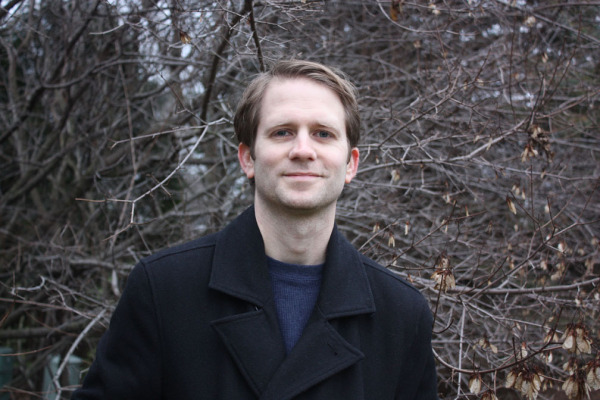
Matthew Cordell is the illustrator of over 25 books for children including picture books, novels, and works of poetry. Several of which he has also written, including New York Times Notable picture book, HELLO! HELLO!. Matthew lives in a suburb of Chicago with his wife, author Julie Halpern, and their two children. Visit him online at matthewcordell.com. You can also find him on Facebook and Twitter.
Matthew's two newest books are SPECIAL DELIVERY, written by Philip C. Stead and illustrated by Matthew (Roaring Brook Press), and WISH, written and illustrated by Matthew (Disney-Hyperion).
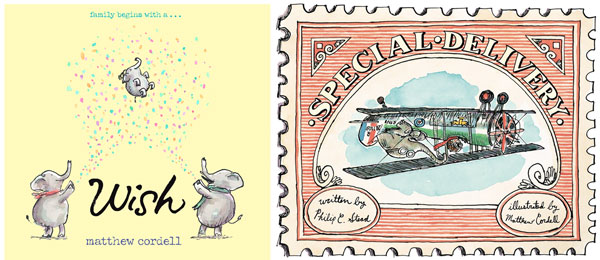
SPECIAL DELIVERY synopsis: Sadie is determined to deliver an elephant to her Great-Aunt Josephine, who lives completely alone and can really use the company. With the help of some interesting characters, she tries mailing the elephant, flying it over, hopping a train, and even an alligator boat ride. This eccentric and hilarious story will surprise and entertain from beginning to end.
WISH synopsis: As an elephant couple embark on a life together, thoughts of children are far away-at first. But as the desire for a child grows, so do unexpected challenges. And it's only after thwarted plans and bitter disappointment that their deepest wish miraculously comes true.
Q: Could you please take a photo of something in your office and tell me the story behind it?
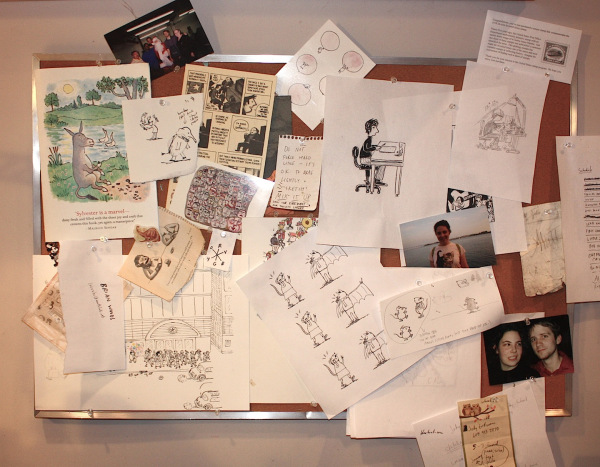
This is a corkboard that hangs in an awkward spot on the wall--kind of hard to reach--between my computer desk and my drawing table. At one point or another over the years, I've tacked up bits of stuff I was working on at the time, images by favorite artists to inspire, and personal photos. Most of the things on the board are ridiculously out of date (I should really put up some photos of my two beautiful children!), but I am rather proud of myself for having the motivation to hang the thing on the wall in the first place.
Q: What advice do you have for young writers and/or illustrators?
I'm not sure how original this is, but I think it's good advice and I wish I had followed it much earlier in my career. Which is this: figure out what makes you unique, interesting, weird, and you. Think about the things that sculpted you in your life, past and present that made you the individual that you are today--your interests, passions, personality quirks, etc. And use this as much as you can in your writing, art, etc. Do not be afraid to let this stuff come out. It's what makes you you and not look like and read like other books that are already in print. It's incredibly hard not to be overly influenced by authors and illustrators from all times (and you will be influenced, and you should embrace that) but you can use that and manipulate it to your advantage too.
Q: What are you excited about right now?
My wife (YA author, Julie Halpern) loves to plan family vacations. I love taking her planned family vacations because she does exhaustive research, plans things out full tilt, and does such an incredible job to insure we get the most of out these trips. We are taking our kids (our daughter's 6 and the boy's 20 months) to Disneyworld this coming fall. Julie updates us everyday on all the stuff we can do together there, how we'll make things work with a toddler, scoring the best deals on stuff, etc. Really looking forward to it. I love books and I love art intensely. But time away with the family is what I really enjoy the most in life.
------
For more interviews, see my Inkygirl Interview Archive.
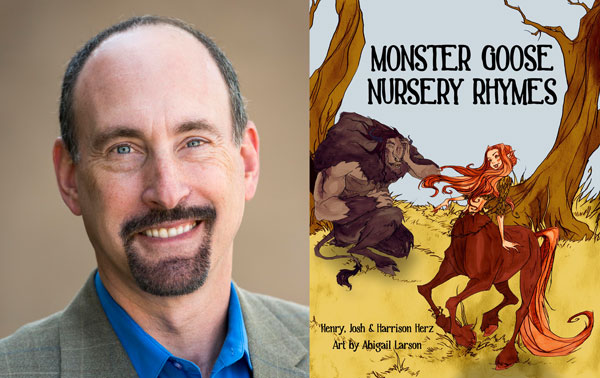
Henry Herz writes fantasy and science fiction for children with his two sons, and his first traditionally published picture book, Monster Goose Nursery Rhymes, launched from Pelican Publishing earlier this year. He is a SCBWI member and hosts a kidlit blog. You can find out more about Henry and his books: Birchtreepub.com - Blog - Kidlit Creature Week -Facebook - Twitter
Synopsis of Monster Goose Nursery Rhymes: Enter an enchanted land of mythical creatures where manticores reign and ogres roar. With a unique twist on traditional rhymes, Monster Goose Nursery Rhymes presents a darker approach to these childhood classics, and yet the sing-song nature of the poems renders them playful and jovial at the same time.
Q. Could you please take a photo of something in your office and tell me about it?
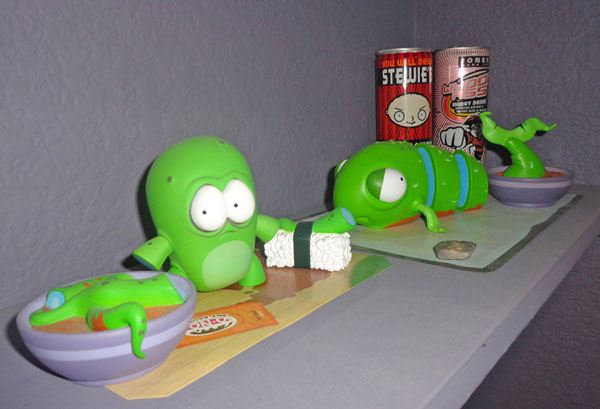
I have a shelf in my office on which I display an assortment of toys and other creatively inspiring objects. In this picture, we see some two sets of O-no-sushi - darkly hilarious vinyl toys. Behind them are two empty soda cans: Stewie's Domination Serum and Whoop Ass energy drink (who doesn't occasionally need a can of whoop-ass?). Lastly, the small pebble is from the Waldon Pond made famous by Henry David Thoreau.
Q. What advice do you have for aspiring young authors and illustrators?
The following advice applies equally to authors and illustrators, young and old (I started my writing career after age 50).
Be tenacious!
1. Never stop honing your craft. Read lots of books. Just as a lion is the product of all the zebras it eats, an author or illustrator is the product of all the books he or she has read.
2. Never stop querying. Now, by that, I don't mean query continuously. What I mean is that even the best authors and illustrators get rejected. So don't let rejection demoralize you. Keep in mind that the publishing world is, in one sense, like dating. What appeals to one person doesn't work for another. Just as you don't stop dating because someone says "no", you don't stop querying because an editor or agent says "no". Remember, J.K. Rowling's Harry Potter was repeatedly rejected. That's like someone turning down a date from George Clooney or Angelina Jolie! The only way you can be stopped is if you give up. Keep on writing/illustrating and keep on querying!
Q. What are you excited about right now?
That's easy! My picture book, Monster Goose Nursery Rhymes, came out in February from Pelican. It's exactly what it sounds like - fractured nursery rhymes with human characters replaced by monsters. The artwork by Abigail Larson is stunning. And the book has garnered some lovely praise from kidlit luminaries like Drew Daywalt, Molly Idle, and Dan Yaccarino.
--------
For more tips and interviews, see my Inkygirl Interview Archives.
Continued from Part 1 of my celebration of today's OUTER SPACE, BEDTIME RACE launch...
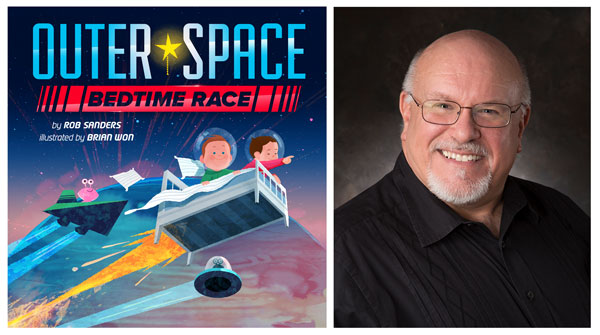
Happy book birthday to OUTER SPACE, BEDTIME RACE, a new picture book written by my friends Rob Sanders and Brian Won, launched today from Random House Children's!
Thanks to both Brian and Rob for answering three questions for me today. In my previous post, OUTER SPACE illustrator Brian Won answered Three Questions. Now it's Rob's turn. :-) I first encountered Rob online through his great Picture This! blog for children's book writers. I've since met Rob in person at a SCBWI-LA conference and am also illustrating his new RUBY ROSE picture book series. Super-nice guy and I love his enthusiasm for children's books.
You can find out more about Rob at his website, blog, Twitter and Facebook.
Question #1: Could you please send me a photo of a random object in your office and tell me about it?
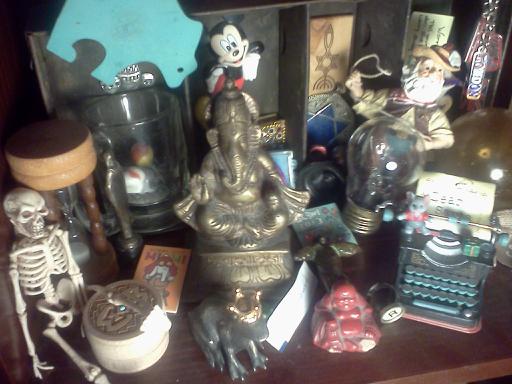
Since I’m bad at following instructions, and since one is never enough—my picture is not of one thing in my office, but my Shrine of the Weird and Wonderful.
This cubby on my desk (just above my computer) houses mementos, well wishes, inspiration, and things that just make me smile. There are religious icons given by friends, a skeleton that reminds me to stick to the basics, a vintage light bulb that reminds me that new ideas are everywhere, a Mickey Mouse magnet—since Mickey was the first iconic American character for kids (in my opinion), fortunes, a frog with a golden crown (just like you have to kiss a lot frogs to find your prince, you have to write a lot of manuscripts to find a story), a small mug of marbles from my childhood (because children are at the center of what I do as a writer), a cowboy Christmas ornament in honor of my first picture book, and more.
Nothing comes out of the Shrine, things can only be added. This little cubby has become my shrine to creativity, to writing, to hopes and dreams.
Q: What advice do you have for young writers?
1. Write. I think most of us spend a lot more time talking, blogging, social media-ing, and thinking about writing than we actually spend writing. Flip that around and you’ll find success. Writing is hard, lonely work—but it can also be fun and invigorating.
2. Explore. Try different styles, genres, and voices. Find what works for you. It’s the old throwing spaghetti on the wall and seeing what sticks kind of thing. And what ends up working for you might be more than one thing. Don’t limit your writing style or your writing opportunitie
3. Read. Know what picture books are out there, which are winning awards, which are breaking new ground. Read classics to know our history. Read current books to know what kids are reading today.
4. Enlarge your circle. Stay in touch with your writing buddies, make new writing friends, meet editors and agents at conferences, friend fellow writing tribe members on Facebook. Get to know people and let them get to know you.
Q: What are you excited about these days?
I am a picture book writer through and through, but I’m really excited these days about a middle grade novel I’m working on. I am working with twenty-three fourth grade students who are critiquing my manuscript chapter-by-chapter—one chapter a day. These insightful kids are exploring character development, pointing out what’s not working in the plot, asking tough questions about motives and logic, pointing out word choices that work and ones that don’t, and spinning the plot in new directions I never imagined.
Many nights I come home from school, revise the chapter we just critiqued, and type up a new chapter. These kids are inspiring me (“I never thought that was going to happen!”), humbling me (“That doesn’t sound like what a kid would say.”), and encouraging me to keep writing (“You only brought one chapter today?”). I’m excited to write for this small group of kids, my own focus group, my own critique group in residence.
------
For more interviews, see my Inkygirl Interview Archive.

Happy book birthday to OUTER SPACE, BEDTIME RACE, a new picture book written by Rob Sanders and Brian Won, launched today from Random House Children's. Thanks to both Brian and Rob for answering three questions for me today. You can also read Rob Sanders's answers to my Three Questions.
Brian is not only the illustrator of OUTER SPACE, BEDTIME RACE but also the author/illustrator of HOORAY FOR HAT!, which came out last year from Houghton Mifflin Harcourt. I met Brian through the SCBWI Illustrator Mentorship program. You can find Brian at BrianWon.com, @bwon1 on Twitter, BrianOneADay on Tumblr, bwon1 on Instagram, and Brian Won Illustration on Facebook.
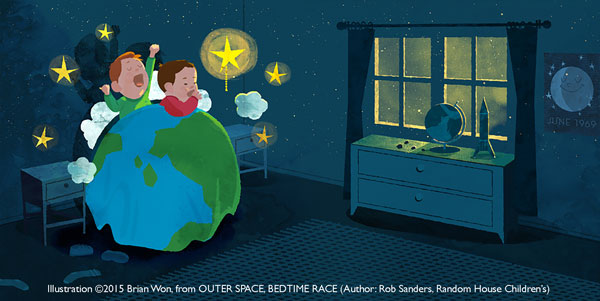
About OUTER SPACE, BEDTIME RACE:
"Aaaaaand they’re off . . . to bed! Aliens from every planet rocket through their out-of-this-world bedtime routines—they sink into steamy crater bubble baths and shimmy into deep-sleep suits, just like you (almost)! Brian Won’s glowing graphic art pops off the page, and Rob Sanders’s goofy rhymes will have kids racing to snuggle under the covers and blast off to dreamland." For more about the book, please see the publisher book page.
Thanks to Brian for answering my Three Questions today!
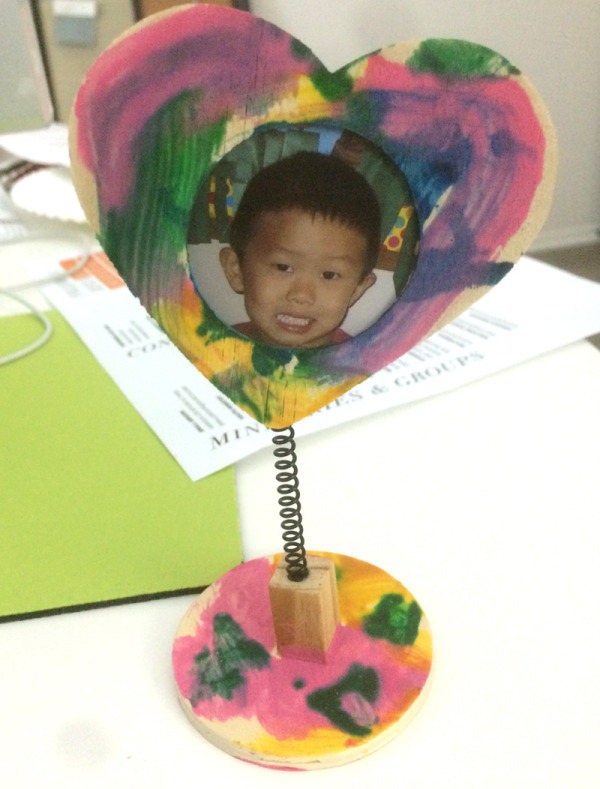
Q. Could you please take a photo of a random object in your office and tell me about it?
This is one of those projects my kid brought home from pre-school. The colors are all over the place but I think its a masterpiece.
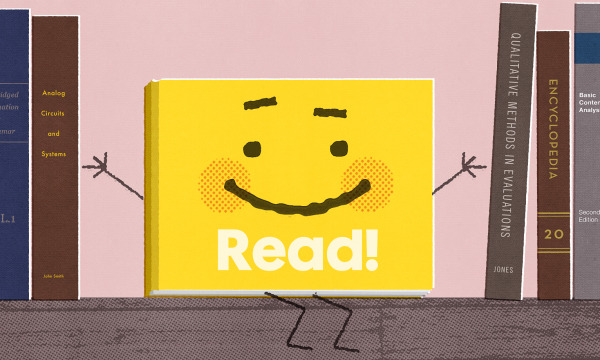
Q. What advice do you have for young writers and illustrators?
My advice for young illustrators and writers is to check out stacks of children's books from your local library. Old books, new books… read them all and study the pacing. There is a heartbeat and rhythm that great books share despite when they were created.
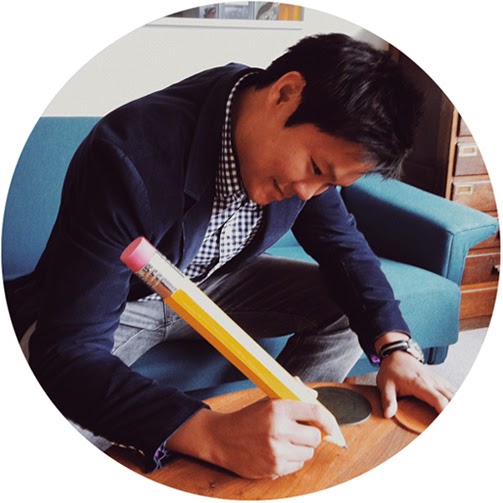
Q. What are you excited about these days?
I'm excited (and deathly afraid) of putting on my writing cap. I have nuggets of ideas for picture book stories I want to tackle. Fingers crossed.
Debbie's book birthday celebration for OUTER SPACE, BEDTIME RACE continues in Rob Sanders's Three Questions post.
------
For more interviews, see my Inkygirl Interview Archive.

I love children's book author Samantha Berger's enthusiasm and creativity. Have you seen her #ePUNymousPortraitSeries? In addition to writing wonderful picture books like CRANKENSTEIN (illustrated by Dan Santat) and A CRANKENSTEIN VALENTINE (sequel). Samantha has written cartoons and promos for Nickelodeon, comic books and commercials, movie trailers, theme songs, poetry, magazine articles. Not only that, but she's also a voiceover artist!
Samantha's newest picture book is SNOOZEFEST, a hilarious and endearing bedtime story written by Samantha and illustrated by Kristyna Litten, just out from Dial Books For Young Readers. It's perfect for anyone who loves sloths, music festivals and/or the joy of SLEEPING. If you're on FB, check out her hilarious #Snoozefest Countdown pics.
You can find Samantha at her website, Facebook, Twitter and Instagram.
Q: Could you please take a photo of a random object in her office and tell us about it?
Yes indeed I can. I took a picture of this lovely grapefruit, that grew right in the back yard! I am working in a California office for a few weeks, and the owner of the house where I'm staying gave it to me. The idea of fruit growing on trees has always been MAAAAGICAL to me, and I may have missed my calling as a migrant worker. And I really want to eat this one, but I have one reservation.
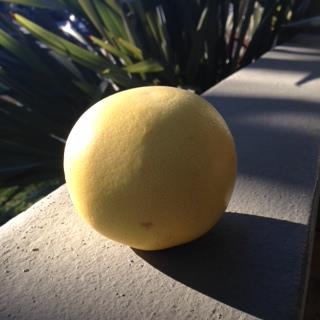
The yard where it grew contains five dogs, using that tree as a bathroom. This grapefruit reminds me to ask the important question: Am I such a germ phobe I won't eat this grapefruit? Or is that grapefruit some kind of dog poo/citrus hybrid. A "pisstrus" fruit, if you will. Stay tuned.
Q: What advice do you have for young writers?
*I would say, if you wanna write, WRITE. WRITE ALL THE TIME, EVERY DAY. WRITE like a passionate discipline, like something you HAVE to do. No excuses. Write.
*Blather, blurt, and blab. Just keep writing. Do not write and edit at the same time. Write, write, write, then go back and read/edit, at a completely different time.
*Make your decisions, all of them, for a REASON. Make no choices arbitrarily. From dedication to author photo, every choice must be made with intent. That is what separates great writing from mediocre. Be prepared to defend every single word.
*Find your best way (pantomime wall building, pretending to erase, meditation) to block out any negators and nay-sayers. There will always be critics, opinions you don't agree with, and close minded haters. Don't engage, always ignore, keep being you, move on.
*Always find time to PLAY and HAVE FUN when you write. Pretend you're not writing for an audience, a paycheck, a critic, a career, a review, an award, an assignment, or whatever, just WRITING FOR THE SAKE OF WRITING, and go create. For the joy of it!
*Own your truth, speak your truth, and become brave enough to write about the things that terrify you the most to talk about.
*Don't dumb down words or ideas. Respect language. It's incredible.
*All writers, whether it's your first manuscript ever, or you're Judy "Prolifika" Blume, go through a perpetual pendulum swing, between excitedly exclaiming I CAN'T BELIEVE THIS CAME OUT OF MY BRAIN and a depressed disappointed "i can't believe this came out of my brain." There are days where we all feel like untalented hacks. All of us. And it's really important to remember this. If you didn't, you probably wouldn't be a writer. So cut yourself a break, go do something that makes you happy, such as a hot tub, a hot sake, or hot stones.
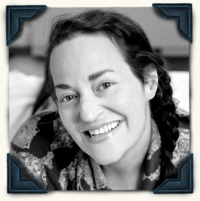 Photo credit: Leo MoretonQ: What are you excited about these days?
Photo credit: Leo MoretonQ: What are you excited about these days?
I'm excited for these spectacular Pacific Ocean sunsets every single night! I'm excited to read Kay Yeh's book THE TRUTH ABOUT TWINKIE PIE! I'm excited to be writing on two new preschool animated originals. I'm excited for karaoke, wigs and sunglasses, glitter-toes, oysters, using the word "smidge" more, and sea-frolicking with my dog Polly Pocket.
I'm excited my book Snoozefest came out this week, and that it has an anthem performed by Chubb Rock, and for the Pajama Party Snoozefest Boozefest I intend on throwing to celebrate. I'm excited about a new 2 book co-author deal with the amazing Martha Brockenbrough and the legendary Arthur Levine. I'm excited to see/conference with/laugh with/write with/ and dance with all my beloved book people and SCBWI-ers again, and for all the incredible books everyone has coming out right now (including YOU, Debbie! Cannot wait for WHERE ARE MY BOOKS!).
Thanks so much for asking me these questions 3 on inkygirl.
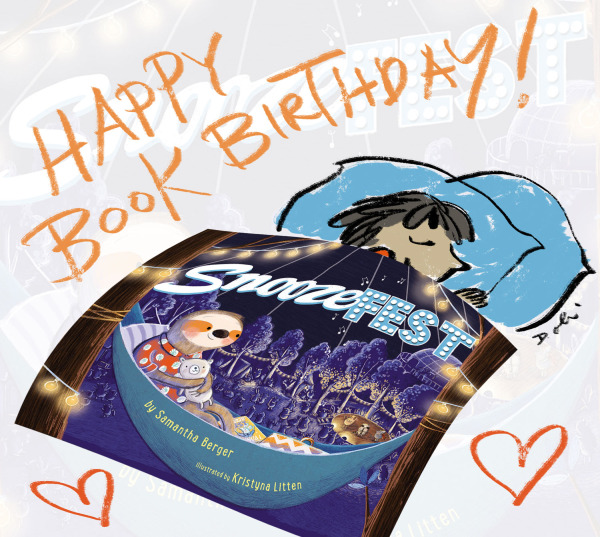 Book birthday doodle I did in celebration of the Snoozefest launch
Book birthday doodle I did in celebration of the Snoozefest launch
------
For more interviews, see my Inkygirl Interview Archive.
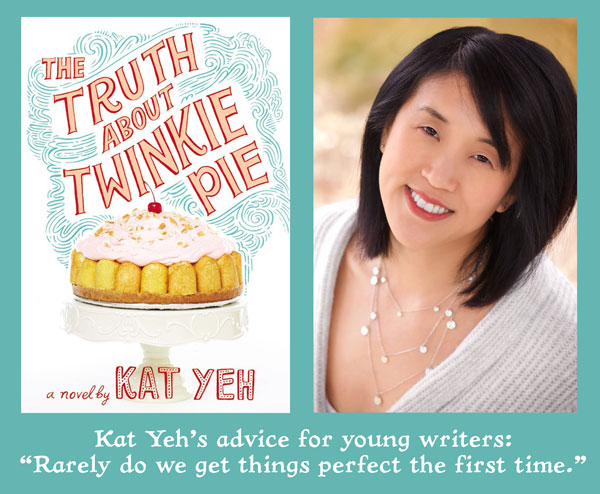
I devoured Kat Yeh's debut middle grade novel, The Truth About Twinkie Pie (comes out from Little Brown later this month), in two sessions. I got so hungry from reading the fabulous-sounding recipes sprinkled through the book that I had to take a break to eat something. Before I stopped, however, I had already teared up as well as laughed out loud at least once. Couldn't wait to keep reading!
Twinkie Pie is my favorite kind of book: a wonderful voice, characters I care about and an unexpected but thoroughly satisfying ending.
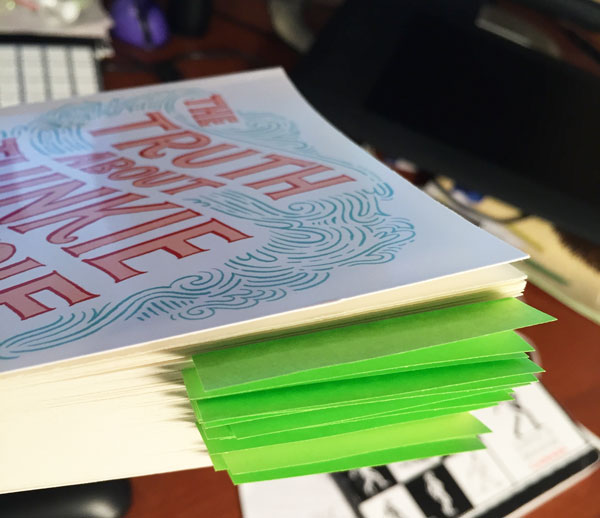 I've marked all the recipes in my copy of Kat's book that I want to try
I've marked all the recipes in my copy of Kat's book that I want to try
I'm also a big fan of food books and food movies. While reading E. Nesbit's books, I lusted after an English Tea years before I really knew what it was. I always felt ripped off when a story text said "they had supper" but didn't give any details. The Truth About Twinkie Pie deftly weaves together the themes of food, family and friendship in an irresistable story about two sisters trying to make it on their own. You can find out more about the book on the Hachette/Little, Brown website.
An aside: I wasn't kidding when I said that the recipes throughout the book sound fantastic. I am SO going to try making No-Peek Chicken, Maybe Even Better Soup, Madder'n Heck Smashed Potatoes, Special-Occasion Fancy Sandwiches, Pull-Aparts, Easier-Than-Pie Pudding, Impossible Pie, Tangled-Up Pie, Heartbreak On Toast, Pick Me Up, Cherries In The Snow, and of course...Twinkie Pie!
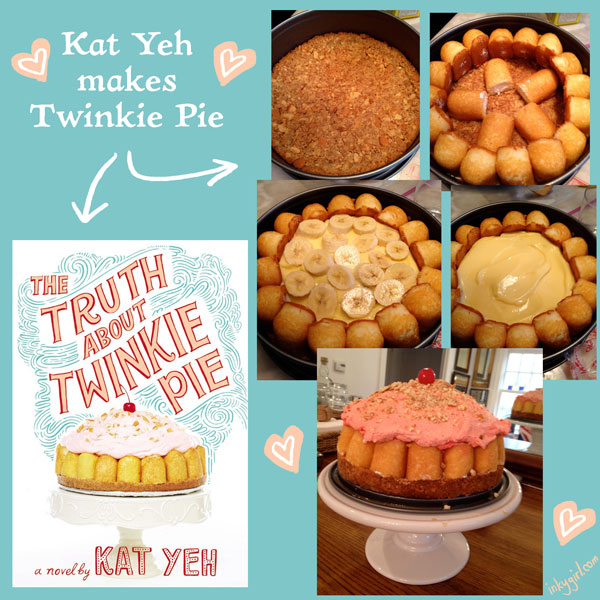
I'm not the only one who loved Kat Yeh's The Truth About Twinkie Pie. Here are just a couple of review excerpts:
"Filled with enough characters and plot for two novels, Yeh’s nimbly voiced, combination fish-out-of-water, personal transformation and emotional family tale is also stuffed with charm." - Kirkus Reviews
"...in her first novel, picture book author Yeh (The Magic Brush) skillfully builds toward a breathless, emotional conclusion." - Publishers Weekly
If you're in NYC, you can help Kat celebrate the launch of The Truth About Twinkie Pie on Sunday, January 25th from 1-3 pm at Books Of Wonder. Wish I could go!
Kat has kindly agreed to answer three questions for me.
Q. How did you come up with those wonderful recipes?
The recipes! That was one of my favorite parts of this process and so much fun! Some of them are just classic recipes that have been around forever (like Banana Pudding) that I tried to give a fun little twist. Some I made up. And some, my friend, Elise Coster, who is a chef, helped me to figure out. There was an awful lot of taste testing going on in my house for a while there. I'm not complaining :-)
Q. What advice do you have for young writers?
Last year, I started a correspondence with a young writer who reached out to me. It's been pretty amazing to hear how passionate she is about writing and creating and to read the questions that she has for me.
Our letters are rather lengthy so I will share only a little excerpt with you:
Dear Kat Yeh,
My name is _______. I’m fourteen years old and also a writer. So far I’ve written two childrens books (although that was in second and third grade), a novel, a play, and I’m currently working on my second novel. I do mostly realistic fiction writing.
My dream is to one day be a published author. I realize that, being only fourteen, that isn’t likely to happen anytime soon, but I was wondering how you actually go about getting something published.
I was also wondering if you ever go back to read something you wrote a while ago, or even a couple days before, and just don’t know what you were thinking when you wrote it. That happens to me a lot and I wanted to know if that happens to other people too.
Kat's Response:
Hi _______
…YES! I often look back at what I've written and wonder WHAT WAS I THINKING?!! This is good.
This means that you are allowing yourself to write without editing yourself. You are allowing yourself free reign to put down whatever it is at the moment that is feeling right and true. THIS is how great writing happens. Here's a secret that most writers know: Writing is Rewriting.
Rarely do we get things perfect the first time. The real art is in the work. Write something. Set it aside. Set it aside long enough that you can see it with new eyes. Read it. Think. Think about why you wrote what you did and what you were feeling and hoping. Edit. Make it better. Set it aside again. Repeat. :)
IF you have friends who also write, think about starting a group in your school where you read each other's work and talk about it. Find a teacher who is willing and interested in reading extra stories outside of class. Yes, you are young, but you already know what you love - this is wonderful!
---
Debbie: Another thing that I often hear young writers talk about is how they get Stuck. And just do not know what to write.
So I tell them what I do. I write anyway.
I write about how Stuck I am.
And I keep going. I go on and on about the Stuckness and how Stuckish it really is and that it's as Stuck as a Stuck door or — or a painted window — you know the kind that has, like, 10 coats of paint on it so that the edges are all painted over and you can't open it. Not even with all your muscles and might! …not even if you HAD to get out because you were hiding in that over-painted bathroom and needed to sneak out the window only you didn't realize that it was stuck and now you can hear the footsteps coming closer and closer as you look at that stuck window one last time before the door knob turns and the door begins to creak open and -
well, you get the idea. You never know where one idea will lead you if you let yourself just WRITE whatever comes to mind. (I'll let the young writers finish that story for me!). What it comes down to is if you're stuck, write about being stuck. If you're bored, write about that. If you feel frustrated, write about that. And go on and on until it turns into something. You can always rewrite. But only if you write to begin with.
Q. What are you excited about or working on now?
I recently finished edits for my next picture book, THE FRIEND SHIP, which comes out next year with Disney Hyperion. AND I'm working on my next novel for Little, Brown which I am crazy excited about and nervous about and so, so hoping that I do it justice!
-----
Find out more about Kat Yeh on Facebook and Twitter.
Kat Yeh grew up reading, doodling, and scribbling in Westtown, Pennsylvania. She worked for many years in advertising and sports marketing — while writing for herself in the wee hours of the night. She currently lives on Long Island where she can see water everyday and explore all the bay and harbor beaches with her family. She is the author of children’s books YOU’RE LOVABLE TO ME, Random House Books for Young Readers (2009), THE MAGIC BRUSH: A STORY OF LOVE, FAMILY, AND CHINESE CHARACTERS, Walker Books for Young Readers (2011), and THE TRUTH ABOUT TWINKIE PIE, Little, Brown Books for Young Readers (launching next week!), and THE FRIEND SHIP, Disney-Hyperion (coming 2016)!
For more interviews, see my Inkygirl Interview Archive.

Kevin Sylvester is not only a talented children's book writer/illustrator and broadcaster, but he's also one of the nicest kidlit people you could hope to meet. His Neil Flambé books for Grades 3-7 are incredibly fun; you can find out more about these and Kevin's other books on his website. In addition to Neil Flambé and the Bard's Banquet (Book #5 of the Flambé series) coming out today, Kevin's Baseballogy: Supercool Facts You Never Knew just came out from Annick.
If you're in the Toronto area this Sat. Jan. 17, 2015, you can meet Kevin at Chapters Markham at 2 pm. Details on Facebook.
1. Could you please take a photo of a random object in your office and tell us about it?
How about this?

It was on my desk when I got the email, so I just picked it up and took the photo.
It's a microphone I use to record the Great Kids, Great Reads podcast. I bought it a couple of years ago and I can take it on the road with my iPad to interview independent booksellers. I've done "on the road" versions in Ann Arbor, New York, all over Ontario and in Phoenix. The podcast is my chance to talk to indie booksellers about their picks for the best books for kids. (It's available on iTunes)
I love independent bookstores a lot. The sellers there read everything, and tapping into their expertise makes me smarter too.
2. What advice do you have for young writers and illustrators?
The best advice is to very carefully examine your favourite artists and actually see how they do what they do.
Do they use simple sentences? Or complex? Do they mix it up? Do they end each chapter with an open question, hooking you in? Do they draw digitally with lots of details? Is line more important than colour? Find out what they do, and how they do it, and then copy them.
Don't plagiarize or steal, but mimic. I read a lot of Artemis Fowl when I was writing the first Neil Flambé and I can see echoes of Eoin Colfer's humour and descriptive sentences in my book. I think my own voice has emerged in the later books in the series (and my new series MiNRS, which launches this fall) but I stood "on the shoulders of giants" to get there. Bob Dylan sounded a LOT like Woody Guthrie on his first few albums, and the Beatles lifted songs straight from Chuck Berry, but that gave them the experience to go beyond.
3. What are you excited about these days?
Space. I grew up with a poster of the universe over my bed and I would stare at it for hours, meditating on the fragile improbability of our existence. 2001 is far and away my favourite movie. I've always wanted to set a book in space, and that book comes out in fall 2015 (MiNRS#1, Simon & Schuster).

But what's amazing (and unintentional on my part) is that we are in a golden age of space exploration right now. The Hubble telescope continues to unlock secrets of star formation, the european space agency landed a satellite on a rock, and NASA is discovering earth-like planets all over the place. Chris Hadfield also stirred up the popular imagination with his time in the space station. So, wow.
You can find out more about Kevin at his website, blog, Twitter and Facebook.
And here's me being all fangirlworshippy at the Inspire! Toronto Book Fair, in the Simon & Schuster Canada booth:

------
For more interviews, see my Inkygirl Interview Archive.
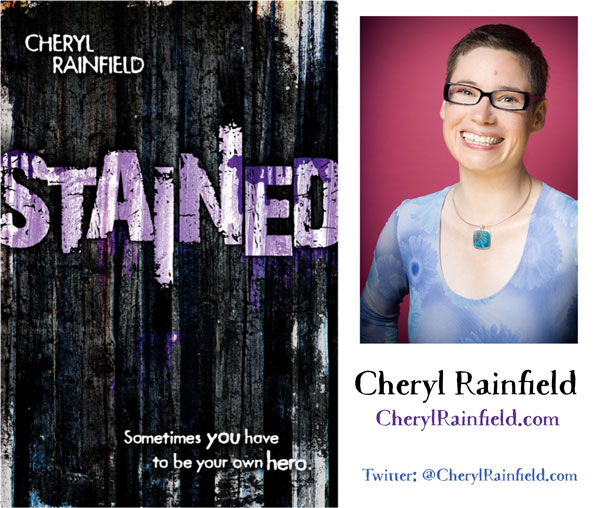
I met Cheryl Rainfield through the Toronto Area Middle Grade/YA Author Group (also known as Torkidlit) and am a big fan of her work (especially SCARS and HUNTED in the past). A survivor of abuse, Cheryl often draws upon her own experience in her intense and highly charged fiction. I love Cheryl's enthusiasm for kidlit/YA as well as her positive outlook and support of others in the community.
STAINED was named one of Bank Street College's Best Books Of The Year (2014) for ages 14 and up, and was a SCBWI Crystal Kite Finalist.
For those in the Toronto area: Cheryl will be speaking about STAINED and signing copies (as well as of SCARS and HUNTED) at Chapters Scarborough at 2 pm on Saturday, Sept. 13th, 2014.
Where you can find Cheryl Rainfield: Website - Blog - Twitter - Facebook Personal/Pro - Tumblr - Instagram - Pinterest
Q. What’s your writing process? Or What was your writing process for STAINED?
A. I write and edit my manuscripts by hand. Longhand writing feels more connected to my inner voice, my creativity, and more alive. And then I type the writing into MS Word. At various points, I also send out my manuscript to other writers to get feedback, and then I revise again. For STAINED, I did about thirteen drafts before it sold to Houghton Mifflin Harcourt, and then multiple drafts before it was published. At one point my editor Karen Grove asked me to try writing some scenes from the abductor’s point of view. I tried, but I think because what I wrote about was so personal—I was drawing on my own trauma and abuse experience—and because I can’t bear to be in the head of an abuser, especially an abuser character based on my own abuser—I found it painful and I struggled writing those scenes. Ultimately I took those scenes out; the book worked better, the way I could write it, with just Sarah and Nick’s alternating viewpoints.
STAINED was the first book I’ve written where I used two different perspectives, and I really enjoyed the process. I put a lot of myself into both Sarah and Nick. I think the alternate points of view helped fill in the gaps in Sarah’s story that she couldn’t know about from her perspective, gave the reader a small breather, and sometimes worked to increase the tension. I also used them to gradually develop the relationship between Sarah and Nick, and the awareness that they really loved each other.
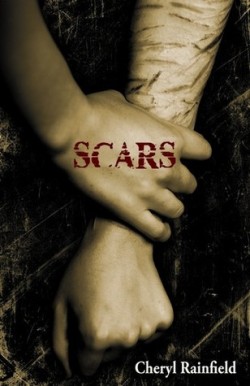 I typically write a lot of drafts quickly, always trying to make the writing and story better, stronger, more powerful, and often doing drafts focused on different things each time. In early drafts, I tend to write the conflicts and tension, the emotion in the characters, the action and plot, and tend to leave out description and setting—I think because as a person and an abuse survivor that’s what I notice most in the world: tension, body language, emotion. So then I have to go back in and layer those things in, as well as symbols and metaphors if I’ve left them out.
I typically write a lot of drafts quickly, always trying to make the writing and story better, stronger, more powerful, and often doing drafts focused on different things each time. In early drafts, I tend to write the conflicts and tension, the emotion in the characters, the action and plot, and tend to leave out description and setting—I think because as a person and an abuse survivor that’s what I notice most in the world: tension, body language, emotion. So then I have to go back in and layer those things in, as well as symbols and metaphors if I’ve left them out.
I also usually have to go back in and intentionally add lightness and breathing room for the reader. I'm so used to tension and fear and and pain—it's what I lived most of my life and know inside out—that putting in happier moments has to be very intentional on my part. I also think tension and conflict helps make a book a page turner—but readers need breathing room, too. I had a lot of fun giving Sarah and Nick a love of comics and superheroes in STAINED, since I also love and read them, and I also enjoyed making Nick draw (I do, too), giving him geeky technological savviness (also my love), and giving Sarah the strength and courage to stand up to bullies who were harassing other kids (also part of myself). And I managed, probably for my first book ever, to give my main character two really good parents--something that comes from my finally having some loving, safe people in my life, and especially my therapist. I think I'm getting better at adding in lightness in my early drafts.
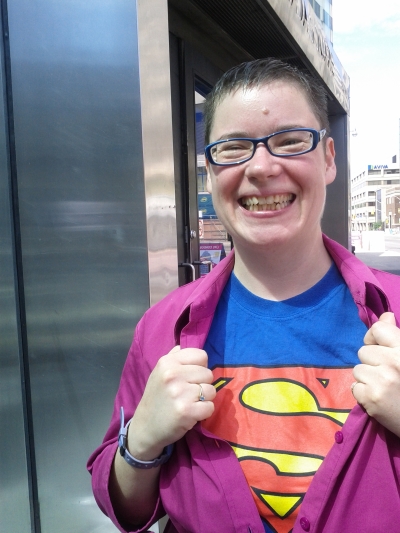
I used to be a pantser writer, not wanting to feel confined by outlines, but I now do outlines with the knowledge that I can change them—and they help me write a lot better, faster. With every book I write, I use THE ANATOMY OF STORY by John Truby to help guide my initial focus, character and plot building, and outline, and also at least my first draft. I’ve found that book incredibly helpful and valuable, as well as a lecture I attended by Donald Maass where I learned a lot more about symbols, parallels, and reversals, which I also add in. And I always, always get feedback from other writers and polish my work before sending it on to my agent. I want my writing to be as polished as it can be before I submit it, so that it’s more likely to get published.
Q. How did STAINED get published?
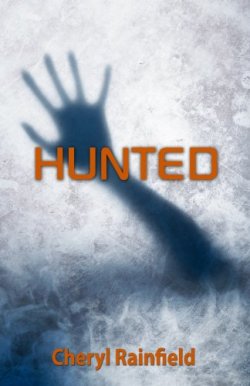 A. My agent at the time—Andrea Somberg at Harvey Klinger—submitted my manuscript to editors and found a home for STAINED at Houghton Mifflin Harcourt. This was a relief to me, since WestSide, the publisher who’d published SCARS and HUNTED, had closed just before HUNTED came out, and I needed a new, stable, and good publishing home. Houghton Mifflin Harcourt has been fantastic with me and STAINED, releasing STAINED in the US, Canada, and the UK, in print, ebook, and audiobook formats. It’ll also be coming out in a cheaper paperback format mid-2015; I’m excited about that!
A. My agent at the time—Andrea Somberg at Harvey Klinger—submitted my manuscript to editors and found a home for STAINED at Houghton Mifflin Harcourt. This was a relief to me, since WestSide, the publisher who’d published SCARS and HUNTED, had closed just before HUNTED came out, and I needed a new, stable, and good publishing home. Houghton Mifflin Harcourt has been fantastic with me and STAINED, releasing STAINED in the US, Canada, and the UK, in print, ebook, and audiobook formats. It’ll also be coming out in a cheaper paperback format mid-2015; I’m excited about that!
I think having a good agent vastly improves a writer’s chances of getting a manuscript published; an agent can submit work to publishers who are closed to writers without agents, and that includes most of the big publishing houses. Although you can get published without an agent, it’s a lot harder. I also learned when I attended college for an editing certificate that publishers generally have two standard contracts—one for authors without an agent, and one for authors with an agent. And the contract for authors with an agent automatically starts at higher royalty rates and better clauses and options. And a good agent knows editors personally and can figure out what manuscript to place with what editor, and also help guide a writer’s career. So I knew I needed an agent.
I actually got my first contract by myself—through the slushpile with WestSide Books—but after years of research, reading writing technique books, publishing industry books, and articles, I knew I needed an agent to negotiate the contract for me, and to help advance my career. I’d initially queried Andrea with HUNTED, which she’d rejected, but her rejection letter was one of the nicest and longest I’d received, and she mentioned hoping to work with me on another book. Her letter stood out to me. So when I got an offer for SCARS (two offers, actually, almost at the same time), I contacted her and asked if she’d represent me, and she did. She also sold HUNTED, and of course STAINED, and I’m grateful for all her help.
Traditional publishing can be slow. I signed the final contract for STAINED in February 2012; I think we got the offer in late 2011, worked on the edits in 2012 (and waited for feedback in between), and then STAINED was published in October 2013. But there’s so much that goes into producing a book—not just the content editing, but also copyediting, proofreading, cover design, interior design and layout, jacket copy, and then also promotion and distribution.
I love what Houghton Mifflin Harcourt did with STAINED—the designer did an incredible, tasteful job with the final cover, pulling a rich, deep purple into the title (because Sarah has a purpleish port-wine stain on her cheek that she obsesses about) and also into the endpapers, and black vertical streaks reminiscent of the cabin Sarah was locked in; the gorgeous texture to the matte jacket; featuring the tagline on the cover: “Sometimes you have to be your own hero;” picking a worn, broken-looking font for the chapter heads with the name and time stamps and initial first words in the first paragraph; using nicely textured cream paper; the readable typeset; and the tiny visual surprise on the hardcover along the spine beneath the book jacket—the title, my name, and publisher info in a gorgeous iridescent purple. I love how a book looks, as you may be able to tell (laughing) so it was a delight to have such care taken with STAINED. Holding a finished book that you wrote for the first time is such a joy.
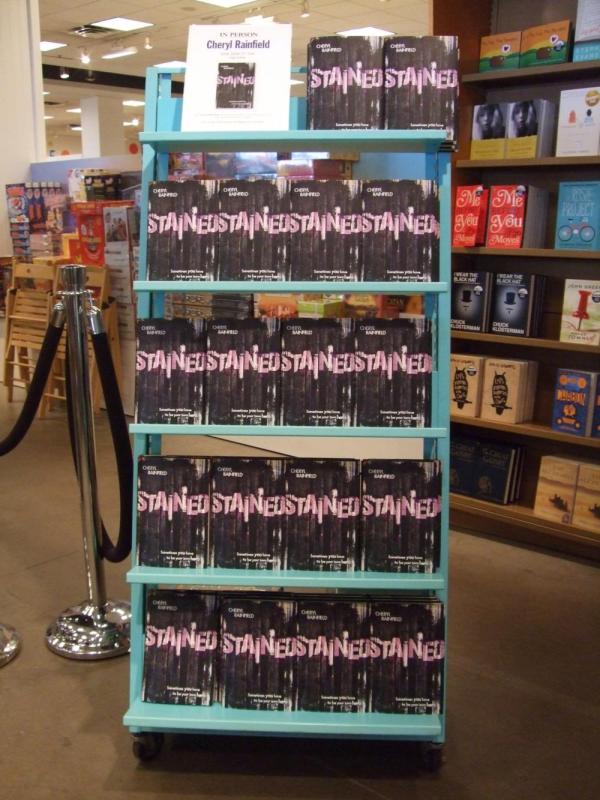
Q. What advice do you have for aspiring YA writers?
A. First—if your dream is to get published, don’t give up.
You may face a lot of rejection over time, but if you persist I think you’ll eventually get published. It took me more than ten years and hundreds of rejections from both editors and agents before I got SCARS published. If I’d given up before then—and in the last few years I was very despairing—then I might never have been published.
Edit your work over and over until it sounds right. One trick I use for some drafts is to read my manuscript aloud. I can hear what works and what doesn’t better that way. It also helps to put your manuscript away for at least a week (I often do two to even four weeks) between drafts before editing again, so that you have as clear a read as possible and can see what’s really working and what really isn’t.
Make sure to get honest feedback from other writers; that can help you advance so much as a writer. Don’t change everything based on what others say, though; make sure to listen to your gut, and to change what feels right. Let the manuscript and feedback sit for a week or more before acting on it unless you’re absolutely sure. I found that joining a critique group of other writers who wrote in the same genre I did helped me immensely; I not only got great feedback, but I also got to hear what worked and what didn’t in others’ writing, and learn from that.
Learn the craft of writing—attend conferences and professional talks, read articles online such as K.M. Weiland’s Helping Writers Become Authors and in magazines such as Writer’s Digest, and most especially read books on writing technique (if you can learn that way) or take some classes.
Writing technique books have really helped me; I’ve read (and bought) more than a hundred books on technique, and I go back and reread some of them and glean new things as I progress as a writer.
If you can't afford to buy them, don't forget about your library! I list a lot of writing technique books I recommend on my blog and website. Two of the most helpful books I read when starting out are Self-Editing For Fiction Writers: How To Edit Yourself Into Print by Renni Brown and Dave King, and Live Writing: Breathing Life Into Your Words by Ralph Fletcher. Later, when I’d learned a lot more about writing technique, some books that really helped me a lot are Techniques of the Selling Writer by Dwight V. Swain, and Bestseller: Secrets of Successful Writing by Celia Brayfield. And right now, my top three current favorites are The Anatomy of Story: 22 Steps To Becoming a Master Storyteller by John Truby, Stein On Writing: A Master Editor of Some of the Most Successful Writers of Our Time Shares His Craft Techniques and Secrets by Sol Stein, and Wired For Story: The Writer’s Guide To Using Brain Science To Hook Readers From The Very First Sentence by Lisa Cron. I also highly recommend The Emotion Thesaurus: A Writer’s Guide To Character Expression by Angela Ackerman and Becca Puglisi.
Learn from them, take what works for you, and discard the rest.
Read. Read as much as you can—for pleasure and for craft. Read in the genre you write in (and hopefully love to read); you’ll learn from it, and you’ll also fill your own creative well. And write about what you care deeply about. Your readers will sense your passion and respond to it.
-----------
For other helpful interviews, please visit the Inkygirl Interview Archives.

I met Christina Farley through my critique group, the MiG Writers. Christy's one of the most productive writers I know, and she recently left her teaching job so she could write fulltime.
Christina's contemporary fantasy novel for young adults, GILDED, launched from Skyscape earlier this year. Its sequel, SILVERN, launches on September 23rd, 2014. You can read the first chapter of SILVERN here.
Other places to find Christy:
Website - Twitter - Facebook - YouTube - Tumblr - Pinterest
Synopsis of GILDED:
Sixteen-year-old Jae Hwa Lee is a Korean-American girl with a black belt, a deadly proclivity with steel-tipped arrows, and a chip on her shoulder the size of Korea itself. When her widowed dad uproots her to Seoul from her home in L.A., Jae thinks her biggest challenges will be fitting into a new school and dealing with her dismissive Korean grandfather. Then she discovers that a Korean demi-god, Haemosu, has been stealing the soul of the oldest daughter of each generation in her family for centuries. And she's next.
But that’s not Jae’s only problem.
There's also Marc. Irresistible and charming, Marc threatens to break the barriers around Jae's heart. As the two grow closer, Jae must decide if she can trust him. But Marc has a secret of his own—one that could help Jae overturn the curse on her family for good. It turns out that Jae's been wrong about a lot of things: her grandfather is her greatest ally, even the tough girl can fall in love, and Korea might just be the home she's always been looking for.
Q. What was your writing process for GILDED?
Coming up with ideas for books can be a challenge, but the idea for GILDED stemmed from the Korean myth of Haemosu and Princess Yuhwa. It left me wondering what happened after Princess Yuhwa escaped Haemosu’s clutches.

The what ifs inspired me to write the story of GILDED. But to writing a full length novel isn’t easy.
1. First I plotted out the story.
See my plot grid for GILDED here:
I also did a blog post on more specifics on how to plot out books here and you can use my templates to get you started here.

2. Next, I prepare to write the book.
I often use aromatherapy (a scented candle) to write as well as create a soundtrack for each book. I love keeping a journal for each book as well. This will have all the names of my characters in it, nuisances, research I’ve done on the book, notes, and illustrations. The journal became extremely useful when I went to write the sequel and had to remember all the small details for characters or the rules of my world. For more ideas, you can check this video I made here: http://www.youtube.com/watch?v=3chpYaMLYxg

3. Once everything is prepped, then I write my first draft. It’s sloppy and a complete wreck, but the structure of the book is in place.
For GILDED I had to do a lot of research of Korean mythology. I also found that since Jae Hwa was a martial arts expert, I had to learn Korean archery and taekwondo because I wanted the book to be as authentic as possible.

4. Revision is where the book comes to life. I revised GILDED so many times I’ve lost track. But each time, I strengthened the book’s structure, working on characterization, description, subplots and the arc of the book.
5. After I think the book is in good shape, I have my critique partners take a look. Debbie Ohi and I are part of the MiG Writers ( www.migwriters.com). I’m indebted to her and the rest of the group for their hard work in helping GILDED shine.

Q. How did GILDED get published?
Finding an Agent:
Once I finished GILDED, I realized I needed an agent for this book. So I did my research mainly on querytracker. I’d look up agents in my field and then research everything I could on them before I queried them. My agented friend’s warned me that a bad agent is worse than no agent, so I when I received offers of representation from agents, I made sure I had a phone conversation with them to see if they were the right fit. I talk more about that here: http://youtu.be/5Kebg57lUJs

Finding a Publisher:
I like to say it was tough work, but my agent, Jeff Ourvan of the Jennifer Lyons Literary Agency, LLC, is completely responsible for selling GILDED. He found the perfect editor for me and I’m thrilled to be working with Miriam Juskowicz.
 Christina with her editor, Miriam Juskowicz.
Christina with her editor, Miriam Juskowicz.
The biggest difficulty I had was decision making. Before signing with Amazon Children’s, there was another unexpected option with a different project. Jeff provided invaluable guidance of what to do for my career long term rather than just signing with the first book offer I was given. I think this all goes back in finding the right agent because the right agent looks out for you not just for the one book, but for your career.
Q. What advice do you have for aspiring YA writers?
My advice for writers is to focus on your craft. Become not only a master of weaving words, but tap into your creative self. If others are writing it, you shouldn’t. Trend chasing will only leave you frustrated. Don’t be afraid to try something new. Challenge yourself to write outside of your comfort zone because in doing this, you are pushing yourself to become everything you can be as a writer.
Don’t base your success on others. You have your own path to follow. It won’t be all grassy fields and stunning mountain peaks. The writer’s journey is a lot like the path through Mirkwood in the HOBBIT. You may feel lost, confused, trapped in the feelings of depression; and if you, don’t be afraid to take a break. Follow Bilbo’s example and climb a tree, leave the forest behind, and breathe in the fresh air.
As Gandalf says, “DON’T LEAVE THE PATH!”

Q. How did the launch for GILDED go?
My launch was amazing. I actually had two launches, a virtual and a physical launch. The reason I did this is I have so many friends from all around the world, including my critique partners! This allowed me to celebrate this special day with them because they have been there with me every step of this incredibly hard journey. It meant so much to me to have them 'there' after all we've been through together. Link for the virtual launch: http://christinafarley.com/the-dream-team/

For my physical launch, I had it at the Windermere Library since it was the perfect location for all of my friends and family to come together. We had 120 people show up and it was overwhelming how kind everyone was to show their support of the book.

After I did a power point presentation about the history of how GILDED came to be, I read a portion of GILDED and then we ate cake and celebrated! While I was signing books, my husband gave away books and swag. It was definitely a day I will never forget. More photos from the physical launch: http://christinafarley.com/gildeds-launch-party-recap/
Q. What are you working on now? Any other upcoming events or other info you'd like to share?
I’m thrilled to say the sequel to GILDED is coming out this fall! SILVERN delves deeper into Jae Hwa’s world. You’ll find out more about the workings of the Guardians of Shinshi and new twists on the Spirit World.
Currently, I have three projects I’m playing with. I’m revising the third book in the GILDED series, drafting a new YA unrelated to the GILDED series, and researching for an historical adventure MG set in the early 1900’s.
 View of Seoul from Christina's desk where she wrote Gilded.
View of Seoul from Christina's desk where she wrote Gilded.
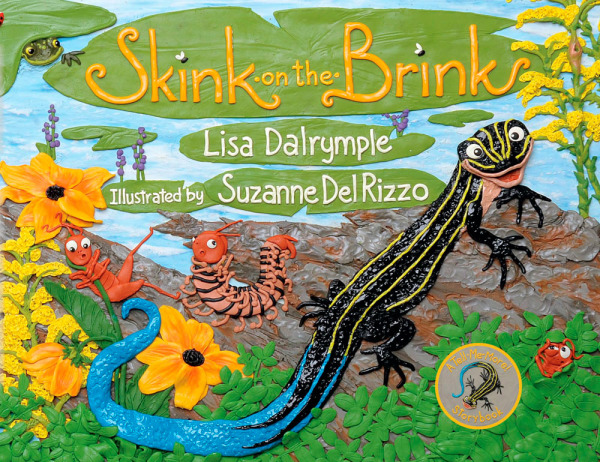
Title: SKINK ON THE BRINK
Author: Lisa Dalrymple - Illustrator: Suzanne Del Rizzo
Publisher: Fitzhenry & Whiteside - June 2013
I first heard about Skink On The Brink at a CANSCAIP meeting. Not only was the title intriguing, but I love the inspiring publication success story (details below). Lisa and Suzanne are popular children's book presenters; their activity session at Toronto's Word On The Street this past weekend drew over 100 young people! Lisa and Suzanne were kind enough to be interviewed for Inkygirl, and both give a TON of valuable info and insights into their process.
 Lisa Dalrymple loves to travel and has lived in such countries as South Korea, Thailand and Scotland. She now lives with her husband and their three children in Fergus, Ontario. Her story, Skink on the Brink, won The Writers’ Union of Canada’s Writing for Children Competition in 2011 and is now a picture book illustrated by Suzanne Del Rizzo. Lisa is also the author of If It’s No Trouble… A Big Polar Bear and its sequel, Bubbly Troubly Polar Bear, coming in October 2013.
Lisa Dalrymple loves to travel and has lived in such countries as South Korea, Thailand and Scotland. She now lives with her husband and their three children in Fergus, Ontario. Her story, Skink on the Brink, won The Writers’ Union of Canada’s Writing for Children Competition in 2011 and is now a picture book illustrated by Suzanne Del Rizzo. Lisa is also the author of If It’s No Trouble… A Big Polar Bear and its sequel, Bubbly Troubly Polar Bear, coming in October 2013.
Where to find Lisa online: Website - Facebook
 Suzanne Del Rizzo loves the squish of plasticine between her fingers. Her illustrations appear in Skink on the Brink (Fitzhenry & Whiteside Spring 2013), written by Lisa Dalrymple. Her cover illustrations appear in the YA novel The Ehrich Wiesz Chronicles: Demon Gate ( Fitzhenry & Whiteside, Fall 2013) written by Marty Chan. She lives in Oakville Ontario with her husband and four children.
Suzanne Del Rizzo loves the squish of plasticine between her fingers. Her illustrations appear in Skink on the Brink (Fitzhenry & Whiteside Spring 2013), written by Lisa Dalrymple. Her cover illustrations appear in the YA novel The Ehrich Wiesz Chronicles: Demon Gate ( Fitzhenry & Whiteside, Fall 2013) written by Marty Chan. She lives in Oakville Ontario with her husband and four children.
Where to find Suzanne online: Website - Twitter - Facebook (personal) - Facebook (professional)
About SKINK ON THE BRINK:
Stewie is a very special skink — he has a beautiful blue tail which gives him a superpower against his enemies. Stewie loves singing his songs and rhymes as he dashes around his home. But as he grows up his beautiful blue tail starts to turn grey — he can't call himself Stewie the Blue anymore! And without his rhymes, his home by the pond doesn't feel as special either. A new Tell-Me-More Storybook about self-esteem, change, and growing up. Includes non-fiction back matter with bonus information and activities.
See the Fitzhenry & Whiteside SKINK ON THE BRINK page for supplemental materials created by Lisa and Suzanne, including coloring pages, activity pages, word searches, and more.
For lots of photos of Suzanne's amazing plasticine-illustration process, read further down in the interview.
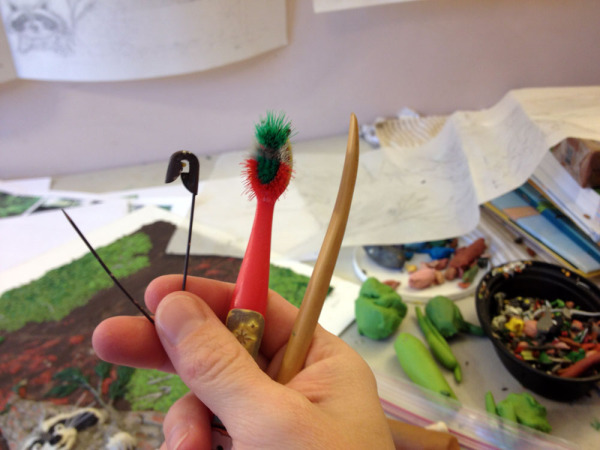 A few of Suzanne's plasticine carving tools. Read further for lots of photos of how she created the amazing illustrations in SKINK.
A few of Suzanne's plasticine carving tools. Read further for lots of photos of how she created the amazing illustrations in SKINK.
Q. What was your publication process for SKINK ON THE BRINK?
Lisa:
I actually can’t remember when I first started researching and writing the manuscript, but I think it was sometime around 2008. (It usually takes a couple of years for me to develop and craft a picture book story until it is finally submission ready.) During this time, I was also working on other books and I was trying to learn the ropes of the publishing industry by getting out, meeting other writers and professionals, and attending trade shows, festivals, etc.
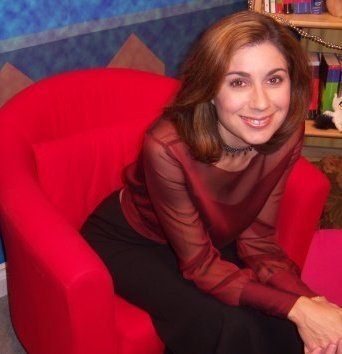 Christie Harkin, editor at Fitzhenry & Whiteside. Photo from Cynsations interview.In September 2010, I went to Word on the Street in Toronto. I remember that it was first thing in the morning that I saw Christie Harkin, the kids’ books editor at Fitzhenry & Whiteside, getting their booth ready for the day. I knew I wanted to talk to Christie, to find out what she was looking for in a manuscript and to establish a personal connection. However, first I had to walk around for a while to try to summon up the nerve. When I finally did, it was the end of the day and Christie was packing up her supplies to go home! She told me that she was developing a line of “Tell Me More” storybooks. In these books, while the story is, of course, the most important element, there’s also an additional educational component that can be more fully explored in the non-fiction back matter. We both agreed that Skink on the Brink might be a good fit for this line and that I should send it to her.
Christie Harkin, editor at Fitzhenry & Whiteside. Photo from Cynsations interview.In September 2010, I went to Word on the Street in Toronto. I remember that it was first thing in the morning that I saw Christie Harkin, the kids’ books editor at Fitzhenry & Whiteside, getting their booth ready for the day. I knew I wanted to talk to Christie, to find out what she was looking for in a manuscript and to establish a personal connection. However, first I had to walk around for a while to try to summon up the nerve. When I finally did, it was the end of the day and Christie was packing up her supplies to go home! She told me that she was developing a line of “Tell Me More” storybooks. In these books, while the story is, of course, the most important element, there’s also an additional educational component that can be more fully explored in the non-fiction back matter. We both agreed that Skink on the Brink might be a good fit for this line and that I should send it to her.
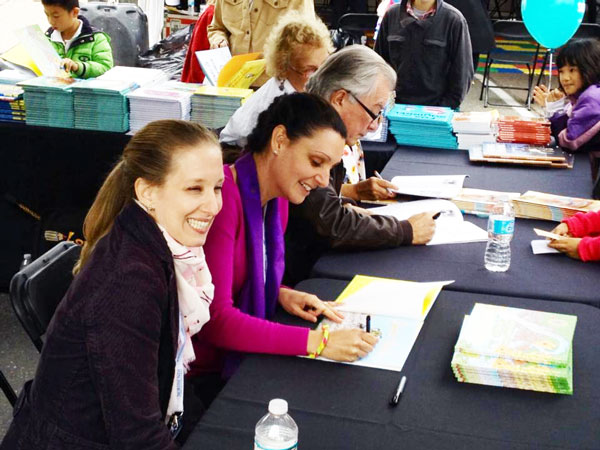 Suzanne and Lisa do a signing with Michael Martchenko & Loris Lesynski at Toronto's Word On The Street
Suzanne and Lisa do a signing with Michael Martchenko & Loris Lesynski at Toronto's Word On The Street
There was a long period where I heard nothing, but I was getting used to no response if an editor really wasn’t interested. By the time February 2011 rolled around, I had completely given up. I went with a group of friends to the OLA Superconference in February and some of them stopped by the Fitzhenry & Whiteside booth to say ‘hi’ to Christie. When she noticed my nametag, she said, “Hey! You’re the skink lady!” I’d never been so excited to think that she remembered me and my manuscript. We had a “pre-editorial” discussion right there and I went home to create yet another draft of the book I’d now been working on for three years.
 When April 2011 rolled around and neither of the books I had under consideration with two separate houses had yet acquired that elusive “yes,” I submitted them both to the Writing for Children competition hosted by The Writers’ Union of Canada. This competition receives between 600-800 entries each year and I submitted every year so, of course, I had no real expectation that I would win.
When April 2011 rolled around and neither of the books I had under consideration with two separate houses had yet acquired that elusive “yes,” I submitted them both to the Writing for Children competition hosted by The Writers’ Union of Canada. This competition receives between 600-800 entries each year and I submitted every year so, of course, I had no real expectation that I would win.
But then there was a day, the same day that I heard from Tuckamore Press that they were ready to send me a contract for my book If It’s No Trouble… A Big Polar Bear, when the phone rang and Nancy MacLeod informed me that Skink on the Brink had won the competition – and that I was sworn to secrecy for almost a week! By this point, Christie and I had a friendly relationship and I think it may have been my post on Facebook, “This is one of the most exciting days of my life,” that prompted her to get in on the excitement and send me my first official book contract!
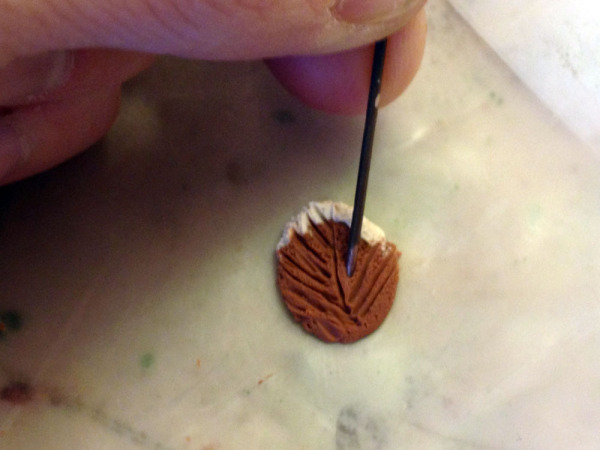 Suzanne adding detail to one of her illustration elements. Wow.
Suzanne adding detail to one of her illustration elements. Wow.
In October 2011, we signed the contract and Christie let me know that they were considering Suzanne Del Rizzo to illustrate the book. She sent me a few samples of Suzanne’s work. Of course, I was thrilled! Suzanne’s plasticine artwork is beyond anything I would have imagined for Stewie and his story and I was so excited to see it finally start coming to life.
In January 2012, Christie and I got started on the ‘first round’ of edits, which actually became the ‘never-ending round’ of edits as we kept passing the manuscript back and forth, trying to get some of the rough spots ‘just right’ so that Suzanne could get started.
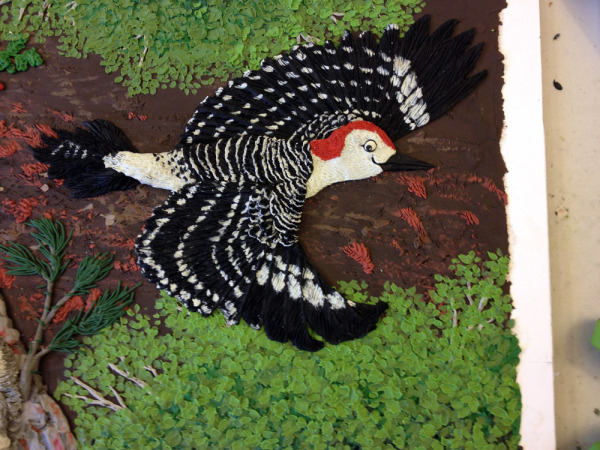
And then the real fun began. I was so excited that Suzanne would consult with me about the illustrations. Her artwork was fabulous and she wanted to check in with me from a research perspective. We both wanted to make sure that we were using our combined knowledge to make sure that the book was as biologically accurate as possible.
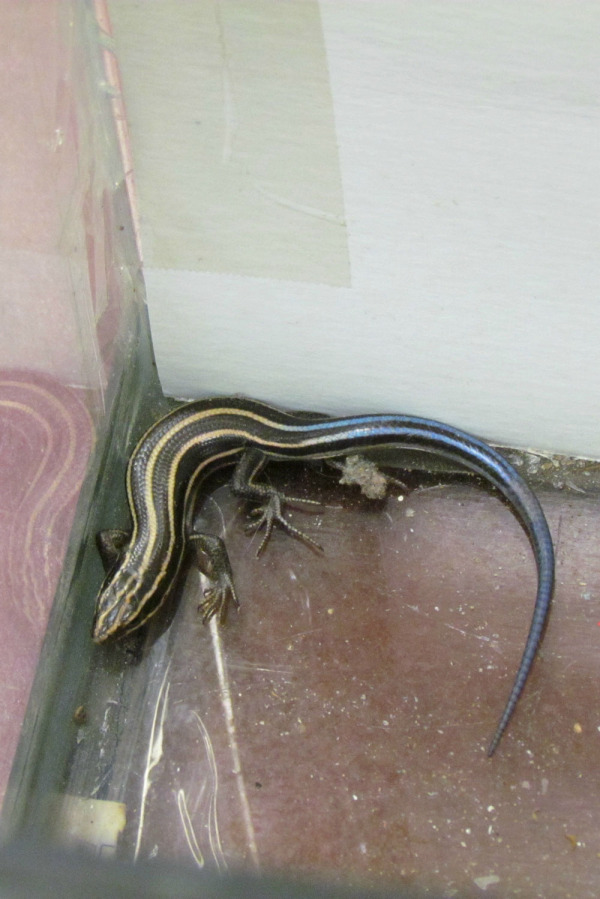
Once the artwork was done, in January 2013, I received the ‘final round’ of edits from Christie and the book went to the printer. Then, in May, Suzanne and I were able to drop by the Fitzhenry & Whiteside office to finally hold the finished book in our hands!
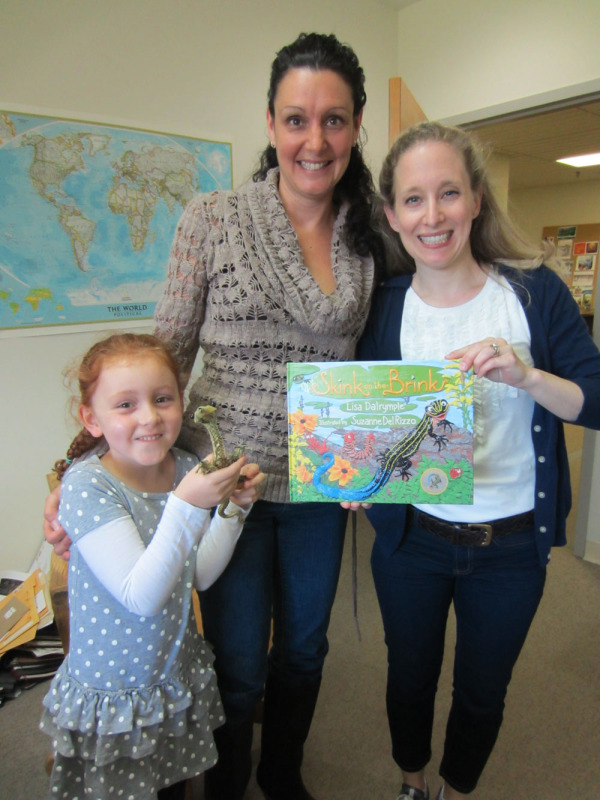
Q. What was your writing/illustration process for SKINK ON THE BRINK?
Lisa:
I wish I could say I have a process that indicated some sort of routine but, working from home for the past few years with small kids around, any routine has been pretty hard to establish. I’m hoping this will improve when my youngest daughter starts school fulltime this year because I know how important it is to have that dedicated writing time. 98% of writing is pure hard work – just keeping that butt in your chair and working, preferably with few to no interruptions! Sure, there’s that other 2% of writing that’s genius inspiration, where the brilliant ideas come to you (usually in the shower) and you hop out, words already flying from your fingertips. That kind of writing can be done almost anytime, anywhere (although I would recommend getting out of the shower first.) But the other 98% is very difficult to do when there are so many demanding distractions of family life and when we all know how tempting it is to give in to distraction in the first place.
At the same time, my kids make huge contribution to my writing process. Getting their input and ideas, as I’m crafting a story is an invaluable part of the process for me. I can’t tell you how many years we’ve spent out in the wilderness on family camping trips, pretending to be skinks and shouting things like “I’m Stewie the Blue” over the pond – and how informative and inspiring it is to see how kids engage with your story when it’s still all coming together in your mind.
Suzanne:
My process for this book began with lots of research. I must admit, I’d never heard of a skink before reading Lisa’s manuscript, so I had some homework to do before I even put pencil to paper. I researched all I could online and from books, and took photos at my cottage (which falls within the geographical region of the Common Five-Lined Skink’s habitat) to create a massive photo reference file:
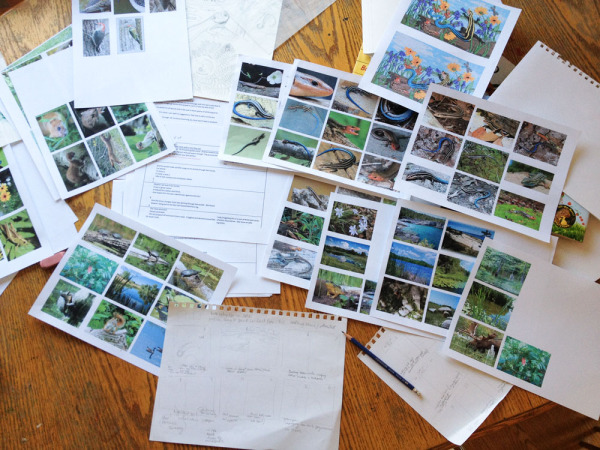

Lisa also provided me with some great shots she had taken while at The Pinery Park where she had seen a Common Five-Lined skink up close. Stewie the skink would be undergoing both physical growth and coloration changes throughout the story, and because this was also a Tell-Me-More story book with accompanying cross-curricular back matter; I wanted to ensure I was maintaining as much biological accuracy as possible.
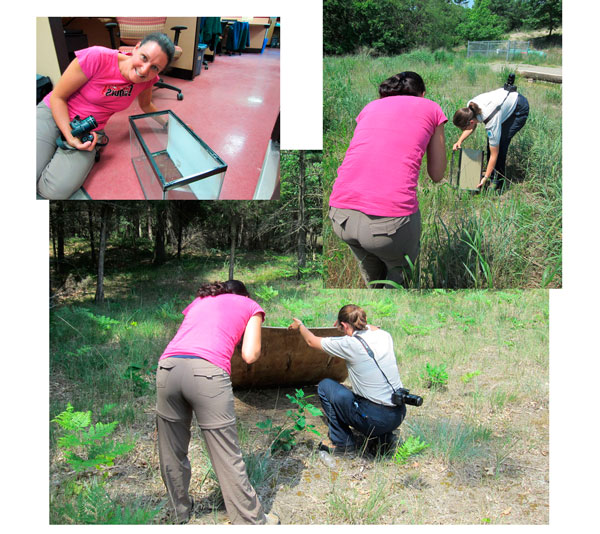
I envisioned having lots of secondary animals and vegetation to make Stewie’s habitat rich and authentic, so I also needed to familiarize myself with the various animals and plant life that co-exist in his habitat. I then created some sample art for Christie to show at the sales meeting, and after landing the contract, I began thumbnail sketches.
Christie encouraged Lisa and I to get in touch and bounce ideas around. It isn’t always standard for authors and illustrators to discuss a project, but in this case, I think it really helped us achieve something special with this book, it was a fantastic collaboration. It even led to some hilarious “oops” moments...like the time when I made a minor flub and put a moose in one illustration... moose don’t extend quite this far south- oops. Luckily Lisa caught it and it was easily changed to a white-tailed deer. If you look closely on my full- sized sketch:
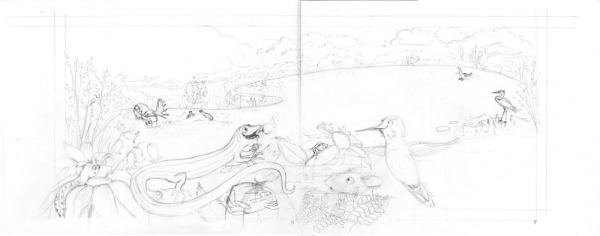
...you can see the moose, yet in the final plasticine illustration it has been changed to a white-tailed deer:
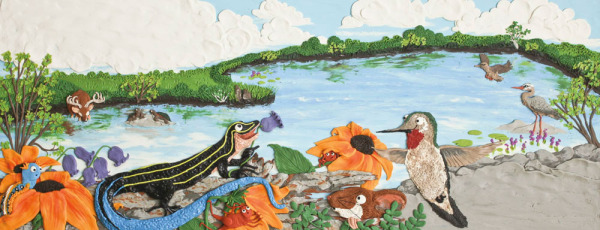
Once thumbnail sketches were approved I worked up full-sized tight pencil sketches:
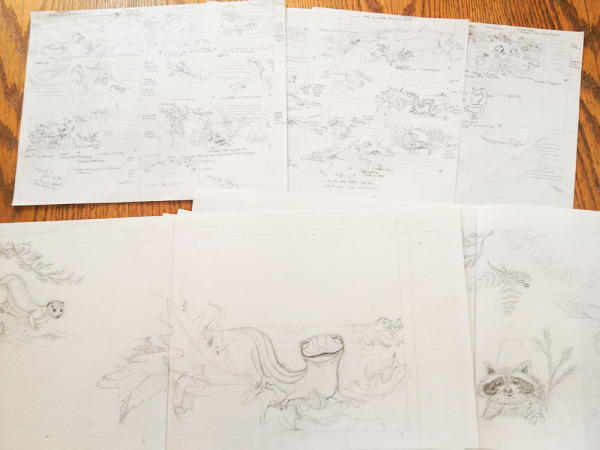
Because I work in plasticine, I prefer to create very detailed, tight pencil drawings to show my editor, and ideally make changes at this phase of the project. Each plasticine illustration can take from 20-40+ hours to create, depending on its size and complexity, so it’s much easier to erase a few pencil strokes at this point then to peel off/redo the plasticine final art.
My illustrations are essentially low relief sculptures created in plasticine(modelling clay) and pressed onto illustration board. The final plasticine art is then professionally photographed:

Before I started any final art I premixed the colours, after some initial colour studies, to create a colour chart:
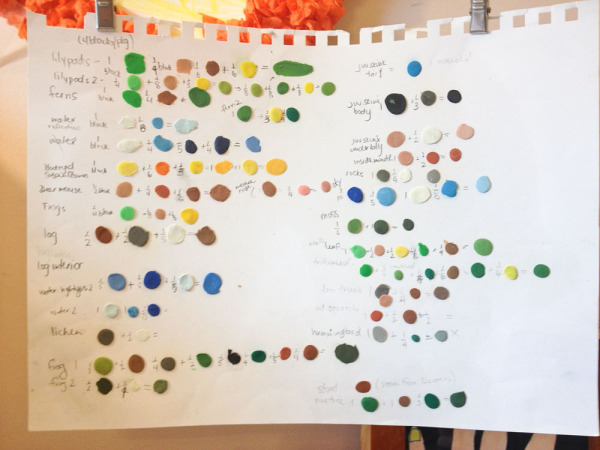
I hang this next to my sketch for quick reference. Then I made up large amounts of my colours so I’d be able to maintain consistency throughout the illustrations. This type of chart comes in handy if I run out of a colour and need to make more. To begin each illustration, I’d smear on plasticine in a thin layer to create the background, then gradually build up and add on, then move onto foreground objects as I go:
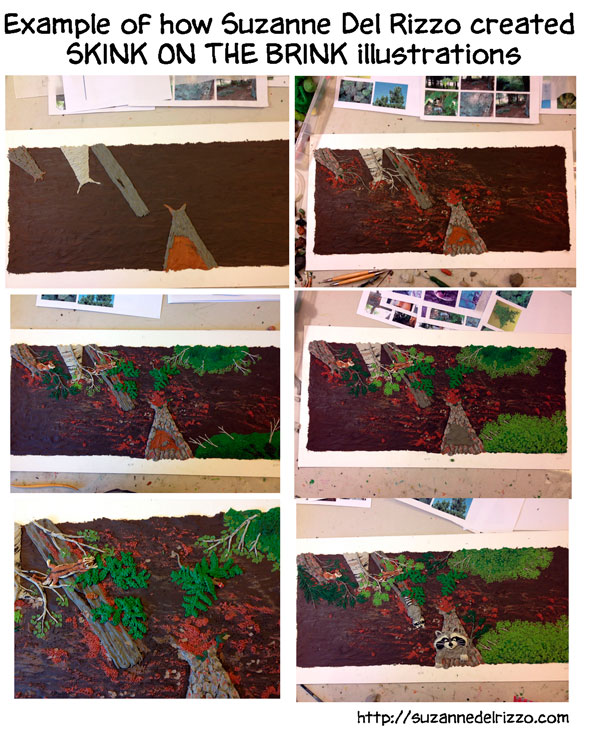
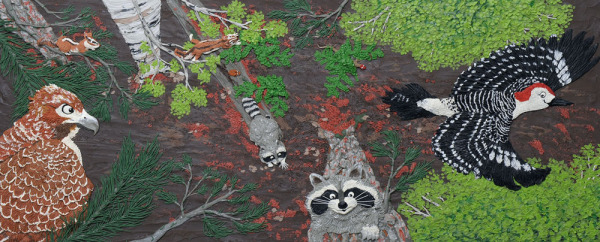
(From Debbie: click here for a close-up look at some of the detail in the final illustration)
One of my favorite parts of any illustration is adding the final textures and details to really bring life to the piece. I use a variety of clay sculpting tools but often times I end up using my good ol’ favorites-a large safety pin, toothbrush, toothpick and my fingers. Sometimes I even make my own tools. For Stewie the skink, I made a selection of polymer clay tools that make impressions of reptile scales:
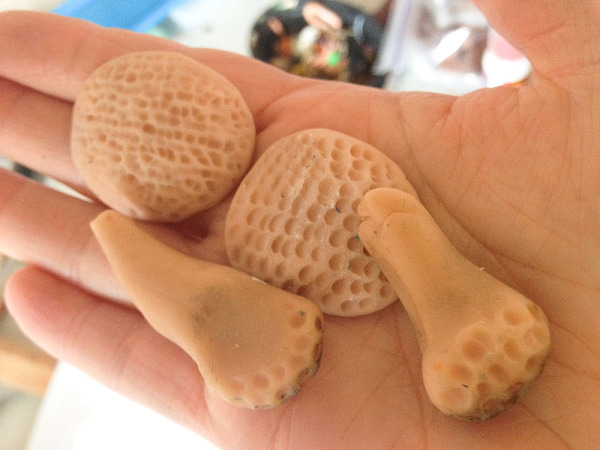
then I used an acrylic gloss to make him glisten.
For intricate parts, I sometimes worked on top of a Ziploc bag that I’d place directly over top of my sketch:
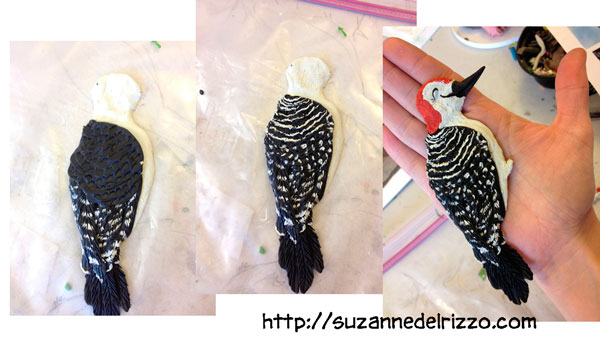
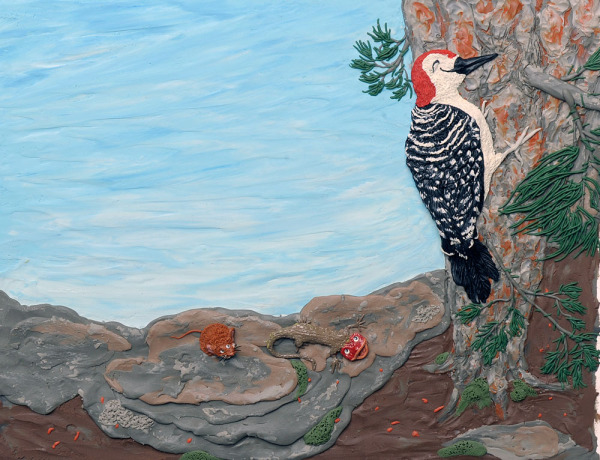
(Note from Debbie: Click here to see details in a bigger version of the woodpecker)
Then I could check to ensure that my sculpted objects were the correct size- plasticine has a tendency to spread and flatten as you work with it, which can be frustrating. So I kept a bowl beside me for my “rejects”...and believe me there were plenty. Faces are especially tricky to get just right. But that’s the great thing about plasticine- it never hardens, so you can just peel off the offensive bits and smoosh ‘em, and start afresh. My kids like to raid the reject bowl (as they call it) and put these bits to use in their own creations.
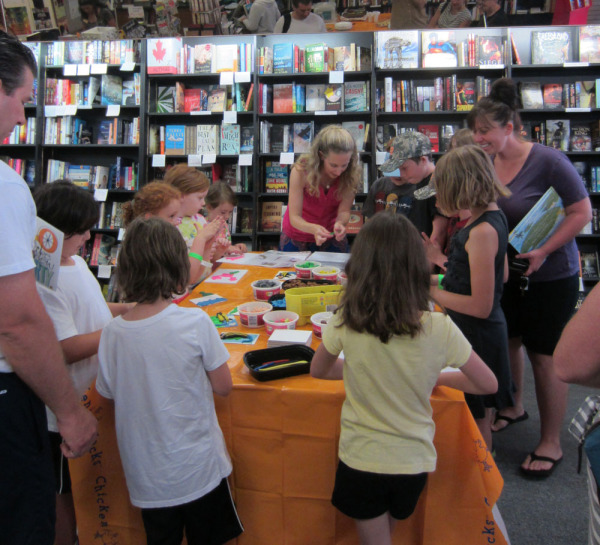
Having a little kiddo sitting next to me on the floor, working on their own plasticine is one of the best perks about having my art studio in my home. Kids are also the best source of inspiration.
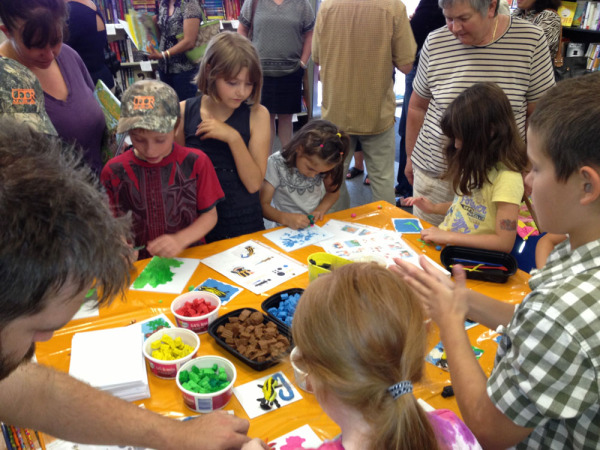
Q. What advice do you have for aspiring children's book writers and illustrators?
Lisa: There is so much important advice out there given by far more experienced writers than me – but you’re not going to hear any of it if you’re sitting in your house staring at a cursor on a screen...
Suzanne: ...or working away in your art studio. And I’m even more “green”, LOL but I am always happy to share what I have found helpful on my pursuit to publication.
Lisa: Get out there and meet other writers and creators. The camaraderie and support of a network of peers is invaluable – for information sharing, providing a shoulder to cry on (or a glass to clink with), for forming critique groups and for gaining access to all that wonderful advice.
Suzanne: Yes, you said it Lisa! We creative types tend to be an introverted lot, but it’s so important to put yourself out there and meet others, connect, share ideas and soak up advice from more seasoned author/illustrators. I have found this community of author/illustrators, both online and in person, to be extremely supportive and encouraging
Lisa: In Canada, some good places to start are organizations for children’s writers such as CANSCAIP and the Canadian Children’s Book Centre (CCBC). Internationally, look into the Society of Children’s Book Writers and Illustrators (SCBWI). Any festivals, trade shows or signings in your area that have anything to do with books can also be useful places to connect with other writers or industry professionals.
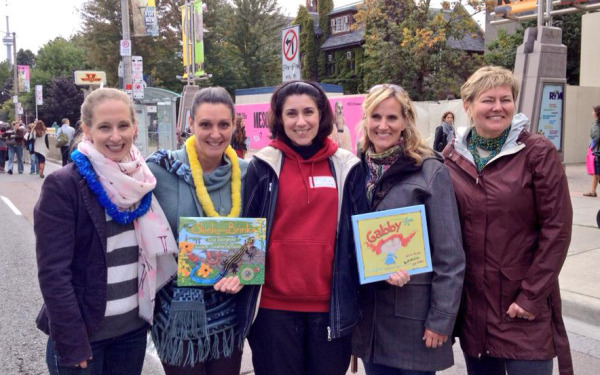 Suzanne and Lisa with their editor Christie Harkin (in red shirt) and friends Jan Dolby & Joyce Grant at Toronto's Word On The Street
Suzanne and Lisa with their editor Christie Harkin (in red shirt) and friends Jan Dolby & Joyce Grant at Toronto's Word On The Street
Suzanne: The thought of attending a large conference might be utterly terrifying if you are just starting out, so start small. Check out the monthly CANSCAIP meetings, or go to Word on The Street and mingle at your pace, or hop online and get to know the Twitter and Facebook community of illustrators and kidlit writers. I must admit to having a bad case of “imposter syndrome” when I first made the career switch from working in a science research lab, after all I didn’t have an art degree. Could I make a go of it as children’s book illustrator? I decided to be brave and just go for it. The self doubt still creeps up on me some days. But I had to start somewhere. Those first small steps, attending meetings and making initial connections paved the way to bigger conferences and helped me gain my footing as an illustrator.
Joining a critique group is invaluable. We often work in a bubble, isolated, “in the zone” creating, be it painting, sculpting or typing away the hours on our tread-desk. We tend to be our toughest critics which can often lead to self-doubt or worse still the dreaded “analysis paralysis”. Crit groups will not only help you grow as an artist, by pushing you in a direction you may never have considered on your own, but they also give valuable, honest criticism of your work and provide a safe environment to share new ideas, ask those silly questions, and learn about the industry. I belong to a few crit groups, one of illustrators, and another of authors and author/illustrators. Authors and illustrators look at manuscripts (and artwork) from a different perspective, and it can be very helpful to get both types of input, especially if you are interested in writing and illustrating, as I am.
Lisa: A critique group is really important. Even if your writing is already awesome, there is so much to be learned from seeing other perspectives on your work. Engaging with other people’s stories when offering a critique has taught me to see my own work with a more critical eye and helped me to develop further focus and direction in my own writing.
Suzanne: Like I mentioned above, get online and make connections. Joining Twitter, and Facebook is one place to start. Every Thursday at 9pm EST there is a Tweet Chat of kidlit creators, just follow #kidlitart, and check it out. They are a welcoming and fun bunch. Zero2illo is another fantastic resource I found extremely helpful when I was starting up my illustration career. It has many great resources, from setting up your portfolio website to designing a business plan. I also belong to their zero2illo confidential, a crit group of sorts but so much more.
Lisa: If anyone reading this has any further questions, or would like direction to an online critique group for serious children’s writers, they can feel free to contact me through my website. (www.lisadalrymple.com)
Suzanne: Yes, please contact me through my website (suzannedelrizzo.com) if you have any further questions.
Q. What are both of you working on now? Any other upcoming events or other info you'd like to share?
Lisa:
Suzanne and I have decided to dub the past few months “the Summer of the Plasticine Road Show.” We’ve been taking Skink on the Brink and Suzanne’s fun and interactive plasticine workshops to events all over southern Ontario. For the fall, it looks like the Plasticine Road Show lives on! We were recently at Toronto's Word On The Street; I will be at the Family Resource Centre in Peterborough on September 28th, followed by a signing at Peterborough Chapters; we will be taking part in the Creemore Arts Festival on October 5th.
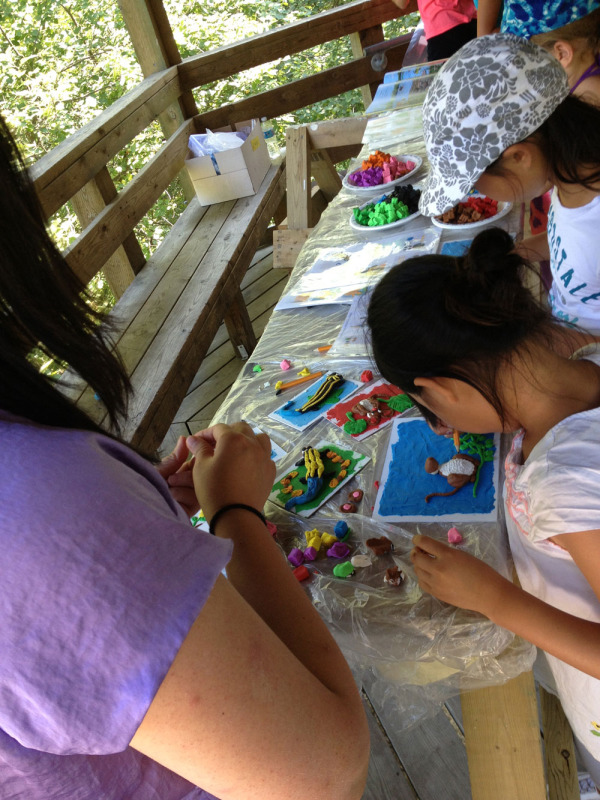
As for what I’m working on now, my third book, Bubbly Troubly Polar Bear, is due out with Tuckamore Books in October 2013.
I’m also very excited about a picture book with a multicultural theme that I’m working on, in which a young Canadian girl travels around the world with her archeologist parents. Through attending school in Thailand, Peru, Jamaica, Scotland and South Korea, she participates in both the differences and the similarities of daily life. I’m hoping to have her experiences to show, through an eight-year-old's eyes, that, while there are many diverse cultures, there can be a common understanding in the sharing of music, food or something as universal as a game of Hide & Seek.
Suzanne:
As for me, I just finished a project for a YA novel cover for The Ehrich Wiesz Chronicles: Demon Gate (Fitzhenry and Whiteside, Fall 2013) by Marty Chan. I created the front and back of a steampunk medallion/Infinity Coil in polymer clay and watch components. I also have another Tell-Me-More storybook project in the works with Fitzhenry and Whiteside. I’m working up some of my manuscripts into picture book dummies for submission as well.
Q. How did your book launch go? And how has reception to SKINK ON THE BRINK been so far?
Complete with plasticine activities and a skinktastic chocolate cake:
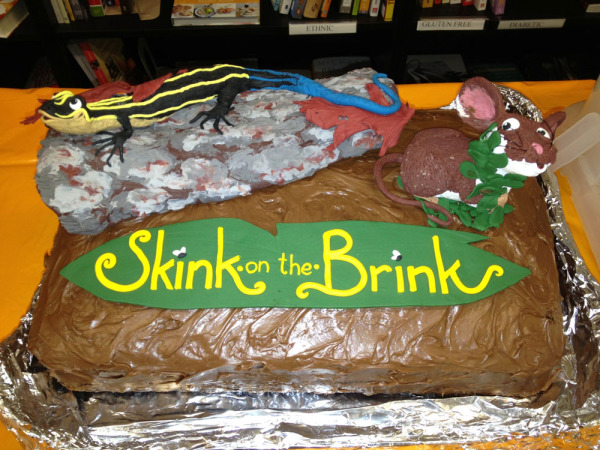
the official launch of Skink on the Brink was at Story Planet in Toronto, but this summer has actually been a series of exciting launch events. We held a second launch at Roxanne’s Reflections, in my current hometown of Fergus and it was every bit as much fun as the first! Then our favourite event this summer was definitely introducing Skink on the Brink to the Pinery Provincial Park at their annual Savannah Festival.
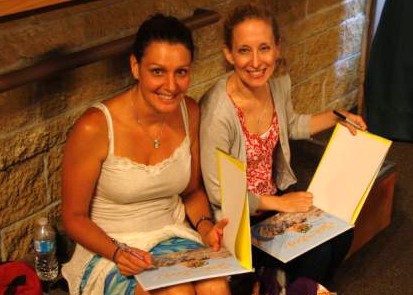
The Pinery is one of the few places in Canada where the Common Five-lined Skink can be found and it’s the area that inspired the character of Stewie and his story. There was something really special about reading Skink on the Brink right in Stewie’s natural habitat and then working with the kids on their terrific plasticine creations on the very veranda where he’s known to hang out and bask.
The kids at all of our events have been tons of fun to work with and incredibly excited – especially those who managed to catch a glimpse of a real Five-lined Skink in the wild, and Suzanne and I now both have households full of plasticine critters! But the best part is definitely hearing the kids’ enthusiasm for conservation efforts and for protecting skinks and their habitat.
------
For more interviews, see my Inkygirl Interview Archive.

SKY JUMPERS - Author: Peggy Eddleman - Hardcover / 288 pages / Publication date: Sept. 24, 2013 from Random House Children's Books. ISBN 0307981274. More info about the book on Goodreads.
SKY JUMPERS by Peggy Eddleman is a fast-paced middle grade adventure with engaging characters and imaginative world-building. I was totally fascinated by the idea of the Bomb's Breath, a layer of chemically altered air that will kill those who breathe it yet slows the fall of Hope and her friends when they jump into it. I can't wait for the next book in the series! Highly recommended.

Book description:
What happens when you can’t do the one thing that matters most? Twelve-year-old Hope Toriella lives in White Rock, a town of inventors struggling to recover from the green bombs of World War III. But Hope is terrible at inventing and would much rather sneak off to cliff dive into the Bomb’s Breath—the deadly band of compressed air that covers the crater left by the bombs—than fail at yet another invention. When bandits discover that White Rock has priceless antibiotics, they invade. With a two-day deadline to finish making this year’s batch and no ingredients to make more, the town is left to choose whether to hand over the medicine and die from the disease that’s run rampant since the bombs, or die fighting the bandits now. Help lies in a neighboring town, but the bandits count everyone fourteen and older each hour. Hope and her friends—Aaron and Brock—might be the only ones who can escape to make the dangerous trek through the Bomb’s Breath and over the snow-covered mountain. Inventing won’t help her make it through alive, but with Aaron and Brock’s help, the daring and recklessness that usually gets her into trouble might just save them all.
About The Author:
Peggy lives at the foot of the Rocky Mountains in Utah with her husband and their three children. She enjoys painting, playing games with her family (especially laser tag), and of course, reading.
Where to find Peggy online: Website - Blog - Twitter - Facebook

Q. What's your writing process?
I know it’s strange, and unlike 97% of authors, but I don’t write in my pajamas. I don’t write on the couch, and I don’t write in bed. Ever. I do line edits on my desktop computer, because it’s easiest there. But my desktop is also where I tackle all the non-writing aspects of being an author, so being in front of that computer distracts me. Plus, I feel like I’m in a cave. And I face a blank wall. It’s all very uninspiring.
 Peggy writing in the Museum Of Art gardens.
Peggy writing in the Museum Of Art gardens.
So when I write or revise, I take my laptop somewhere else. A lot of times it’s my kitchen table, with the blinds on my french doors wide open, spilling in sunshine and a view of the trees, with my hubby and kids nearby. Sometimes it’s on my porch swing on my back patio with the bugs and the cat. And sometimes I go anywhere else. I take a camp chair to the ridiculously beautiful mountains overlooking my valley, I go to the park, the beach, next to a stream in the canyon, or at a neighborhood fast food dive that has the best shakes and who don’t care if I stay forever. The more ambiance and sunshine, the better.
 Peggy writing on the beach.
Peggy writing on the beach.
When I first became a writer, I got my best ideas while folding clothes (which was mightily convenient). Sadly, though, that seemed to wear off. Now I work though the trickiest of plot problems while walking. There’s a great pedestrian canal road that runs alongside my town where I can talk out loud to myself all I want (because that when the best ideas always come, right?), and people are rarely close by enough to care. It gets hot where I live, though. Like melting hot.
 Peggy writing in the mountains.
Peggy writing in the mountains.
Because of my publishing schedule, my summers are always spent deep in revisions, and it’s just way too hot for my canal walks. So I wear paths around my shaded backyard, circling it and circling it and circling it until I come up with my answers. It also gets cold where I live. Like freeze-your-lungs cold. Winter is when I draft, though, and that’s when I’m left to rely on a good ole basket of laundry for ideas.
Q. How did SKY JUMPERS get published?
I decided that I wanted to take the traditional publishing route, and I started by reading everything I could about that process. I poured over writing blogs. I went to conferences and classes and joined critique groups. I made writing friends online. I read post after post about writing query letters. I learned what querying can do to your mental state and prepared myself for it. I learned hot the publishing industry worked. I was determined to go into this with my eyes wide open, and to have myself as prepared as possible for every aspect of it.
 Sending her first pass pages for Sky Jumpers back to NYC.
Sending her first pass pages for Sky Jumpers back to NYC.
After I had a manuscript (my fifth) that was unique, critiqued by dozens, well-revised, and one I knew had a good chance of selling, I set to writing my query letter. Learning so much about getting an agent may have brought out the defeated perfectionist in me. I’m not going to lie– it was very difficult to write my query letter! And it was very difficult to rewrite. And rewrite. And rewrite.
 Signing her contract.I slaved over every word, every sentence, making sure they were the exact right one. And then I’d put it away and bring it out after a week or two, so I could slave over it with a fresh mind. Whenever someone offered a query critique, I took them up on it. I took a query-writing webinar and had an agent critique it. I took conference classes on query writing and had the presenter critique it. I had my sister critique it so many times, I was sure I’d invented a new form of torture.
Signing her contract.I slaved over every word, every sentence, making sure they were the exact right one. And then I’d put it away and bring it out after a week or two, so I could slave over it with a fresh mind. Whenever someone offered a query critique, I took them up on it. I took a query-writing webinar and had an agent critique it. I took conference classes on query writing and had the presenter critique it. I had my sister critique it so many times, I was sure I’d invented a new form of torture.
I’m not exaggerating when I say that I spent five months on it. Was that overkill? Quite possibly. Would I do it again? Absolutely. I’ve gotten some serious mileage with that baby! It got me both an agent and an editor quickly, a lot of the phrases / sentences from it are word for word in my jacket flap, and my agent uses it as an example when she talks about query writing at conferences. Best of all? Those phrases are burnt so deeply in my brain that when someone asks me to tell them about my book, it’s not so hard to tell them.
A question I get asked often goes something like this: “After your editor makes you change a bunch of things, did it feel like it wasn’t your book anymore?”
The answer is absolutely not.
When I got my first edit letter, my editor told me that I didn't have to change a single thing in my book if I didn't want to– that they loved it already and it was good enough to go to print as is. It could've been tempting to just say, “I'm going to leave it as is, then, because it's just how I want it. Then it’ll still feel like my book.” (For the record, it wasn't actually tempting.) Instead, I dove into the 9 page single-spaced edit letter full of really tough suggestions with an open mind and a willingness to work. And then we went through another three tough rounds and a round of tweaks after that before going to copy edits.
 Standing outside the Random House building on a trip to NYC to meet her editor.
Standing outside the Random House building on a trip to NYC to meet her editor.
And do you know what I learned? That there really isn’t anything to worry about when it comes to the book no longer feeling like yours. Editors rarely tell you what you have to do to fix something. They just bring up the issues or places that it can be improved, and let YOU figure out how YOU want it solved. They’ll brainstorm with you on how to fix each thing if that’s what works for you, or they’ll let you figure it out on your own if that’s what works. The point is, in the end it’s still full to the top of your ideas and your writing. It’s just better. Because under the direction and support of someone who is brilliant, your own brilliance can find a way out.
 In the NYC subway, holding her very first ARC of Sky Jumpers.
In the NYC subway, holding her very first ARC of Sky Jumpers.
Q. What advice do you have for aspiring children's book writers?
Three things: be persistent, be teachable, and be flexible.
Be persistent.
This profession is not for quitters. It gets tough and you’ll get knocked down and beat up and rejected a lot of times and in a lot of ways. And the only way you’re going to get through it is if you have a very strong conviction that what you are pursuing is exactly right for you, and that you are strong enough to do it. So when those really tough things happen, you can remind yourself that you were made for this, and you can take anything that’s thrown at you. That you can stand back up, lick your wounds, and most importantly, that YOU CAN DO THIS. That you aren’t going to let a little thing like a harsh critique or a few bad writing days in a row or a rejection letter or even hundreds of rejection letters or shelving a beloved manuscript and starting over again stop you. That when it comes right down to it, you are going to win because you never quit.
 At the filming of her book trailer.
At the filming of her book trailer.
Be teachable.
When you first start writing, it is so easy to feel like you’re an expert. (If you’re in this blissful stage right now, enjoy it. Enjoy it A LOT.) But the truth is, the more you learn, the more you realize you don’t know. You can stay in that stage where you feel like you’re the expert for as long as you want, but you will never improve until you kick yourself out of it. And the only way to do that is by being teachable. When you have someone critique your work, and their critique hurts right down to the center of your soul, resist the urge to get defensive and to decide that they’re wrong. That they just didn’t get what you were going for, or think that they just aren’t as good of a writer as you, and therefore can be ignored. Let those feelings die down and then look at it with fresh eyes. There is truth in every critique if you are willing to be teachable. The thing about writing is that you will never get to the point where you can’t improve anymore, or where you don’t need to improve anymore. Yes. It’s both frustrating and awesome. The really great authors are the ones who never stop learning.
 The kids playing Aaren, Hope, and Brock in the book trailer during their sky jumping scene.Be flexible.
The kids playing Aaren, Hope, and Brock in the book trailer during their sky jumping scene.Be flexible.
Things rarely go according to plan in the writing world. From when you have planned to write, to that one scene not working out, to when you’re going to finish that draft, to when edits will be done, to when you plan to have an agent, to when your book sells, to where your book sells, to what marketing your book gets. Some of those things you can control. And some you can’t, no matter how hard you try to. You kind of just have to go with the flow, and accept that some things happen differently than you had hoped. Sometimes even after getting an agent, your book won’t sell. That’s when you change plans and write another one. Sometimes when you’re sitting down to write, your loved ones will need you. So you change plans and be with your family/friends. The more flexible you are, the more you will enjoy writing.
Q. What are you working on now? Any other upcoming events or other info you'd like to share?
I am just finishing up the very last of edits for book two of Sky Jumpers, which comes out in a year, and I’m gearing up for my launch party for Sky Jumpers. It’s going to be a huge celebration, and I can’t wait!
Where to find Peggy online: Website - Blog - Twitter - Facebook
Her book blog tour continues tomorrow at the Society Of Young Inklings.
RELATED RESOURCES:
Peggy's agent, Sara Crowe, explains why she fell for Sky Jumpers - Literary Rambles
Cover Scoop: SKY JUMPERS by Peggy Eddleman - The Lucky 13s
SKY JUMPERS extras on Peggy's website
SKY JUMPERS on Goodreads
------
For more interviews, see my Inkygirl Interview Archive.
Thanks to Rachel Poloski for being the 24,000th person to follow my @inkyelbows Twitter account. When I went to check her profile, I was intrigued:

Rachel was kind enough to answer some questions for Inkygirl about her work.
Q. Your profile says that you work in production at Abrams on YA and children's books. Could you possibly tell us more?
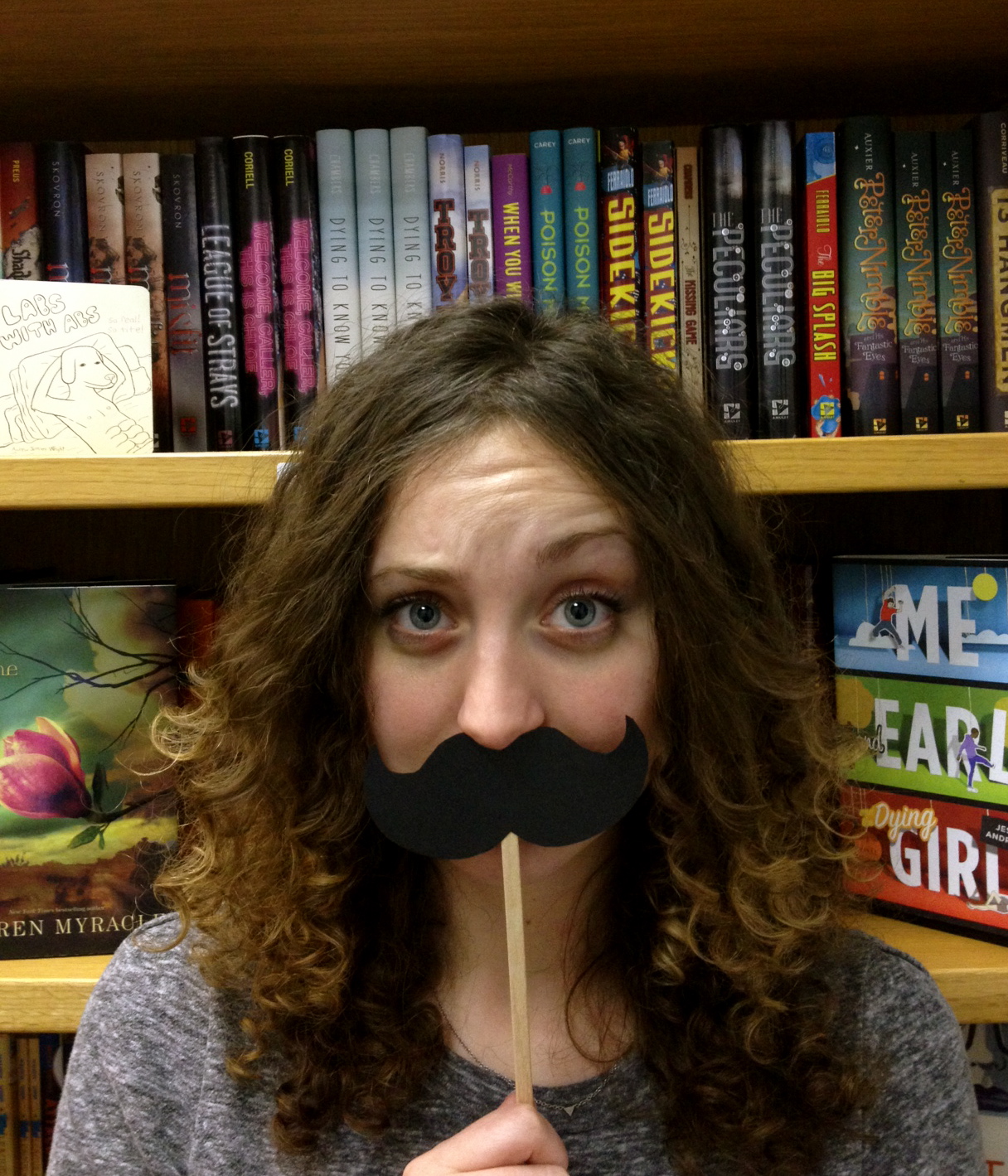 Of course! I work specifically on Amulet Books, which is an imprint of Abrams focusing on fiction and non-fiction writing for middle grade and young adult readers. I also work on reprints across all the children's imprints; Abrams Books for Young Readers, Appleseed, and Amulet Books.
Of course! I work specifically on Amulet Books, which is an imprint of Abrams focusing on fiction and non-fiction writing for middle grade and young adult readers. I also work on reprints across all the children's imprints; Abrams Books for Young Readers, Appleseed, and Amulet Books.
I like to think of Production as the behind-the-scenes of book making. You don’t always see our names in the book or know who we are, but we are involved from start to finish. As production manager of a title, you begin by providing estimates on a book that has not yet been acquired. This enables editors, publishers, and our CEO to discuss the possibilities for the title and if it will work for Abrams. Once a book is acquired, you start forming a schedule based on a publication date or when advances of books are needed.
I work closely with Managing Editorial, Editorial, and Design to keep the schedule on track as well as start working out the book’s specifications. By this I mean the cover stock, text stock, cover effects, inks, trim size, etcetera. We also work out effects on the jacket/cover, which include lamination, embossing, glitter uv (ultra-violet coating), glow in the dark uv, metallic inks, cloth cases, and much more!
For the books I work on, this is the exciting work! Production managers have to be creative and provide ideas to editorial and design in order to bring their ideas to fruition, while maintaining a budget and schedule. Sometime we need to think outside the box and research materials or effects that will accomplish the look and feel the editor and designer desire.
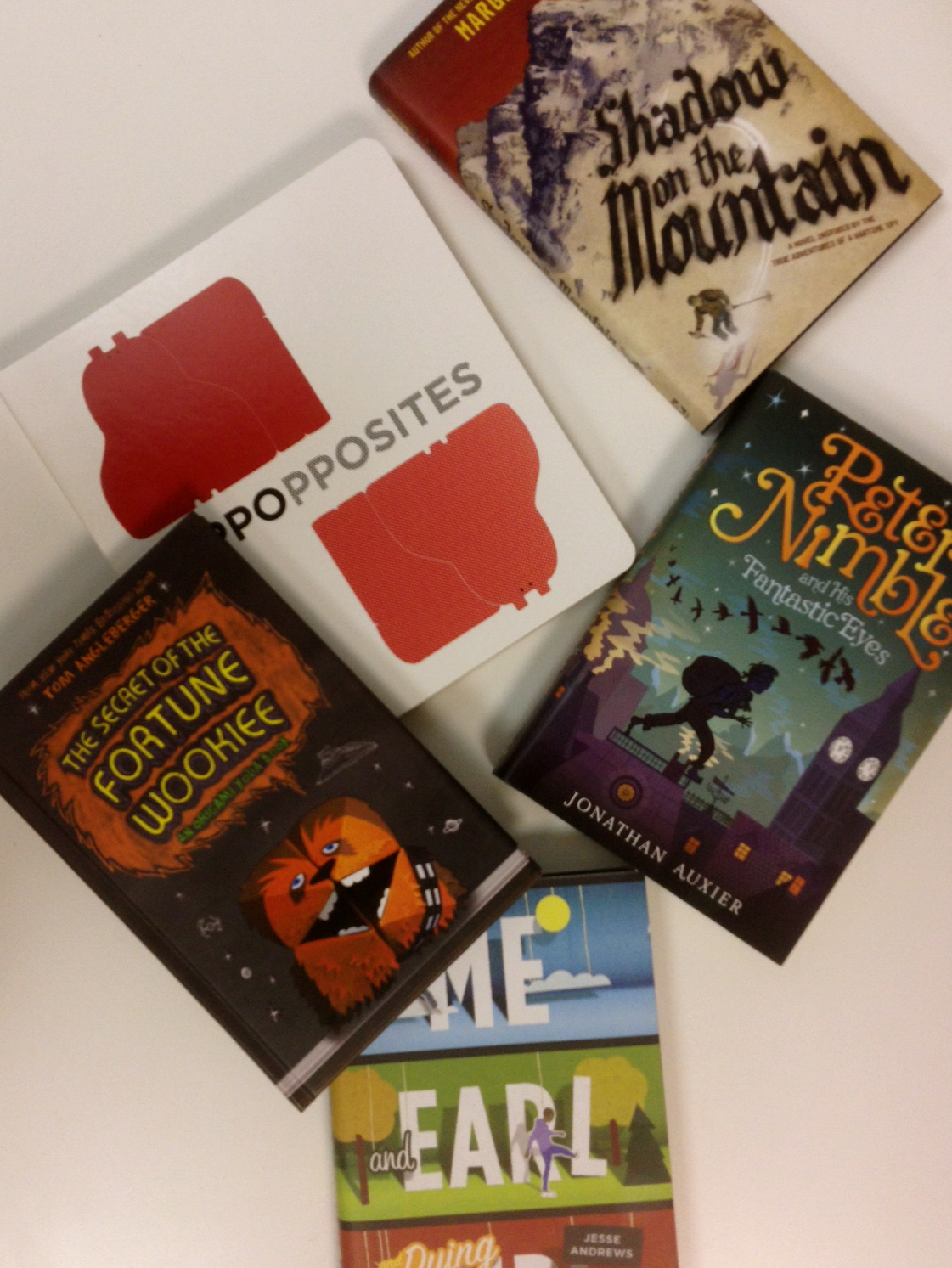 Q. What recent or upcoming Abrams books are you especially excited about?
Q. What recent or upcoming Abrams books are you especially excited about?
I am really excited about working on all my upcoming titles, but specifically I am enthusiastic to work on a new Lauren Myracle title and the final book in the NERDS series written by Michael Buckley! I also just finished working on the paperback edition of Me and Earl and the Dying Girl by Jesse Andrews, which is most definitely my favorite book published at Abrams. It is funny, endearing, unique, and moving. I also had the pleasure of running into Jesse Andrews in the Abrams elevator and he is equally as charming as his writing. He is a both kind and humble. Another hardcover to paperback title I am thrilled to work on is Roddy Doyle’s A Greyhound of a Girl. Such a fantastic book! In Spring 2014 I am also working on new books from Lisa Greenwald and Sarah Skilton, which I am also eagerly anticipating.
Q. What do you write? (aside: I notice that you're a columnist for the Abrams site, for example)
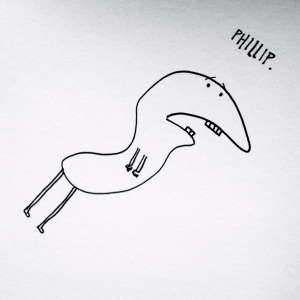 Phillip, by Rachel PoloskiAh, yes. I do write for the Abrams blog, mostly about cooking and then there is the one of me shooting a rifle in the Adirondacks. Don’t worry; this is not a regular sport for me. I do love to cook and bake, therefore writing about it is also pleasurable. Luckily, Abram’s imprint Stewart, Tabori & Chang publishes beautiful and yummy cookbooks for me to test out in the kitchen!
Phillip, by Rachel PoloskiAh, yes. I do write for the Abrams blog, mostly about cooking and then there is the one of me shooting a rifle in the Adirondacks. Don’t worry; this is not a regular sport for me. I do love to cook and bake, therefore writing about it is also pleasurable. Luckily, Abram’s imprint Stewart, Tabori & Chang publishes beautiful and yummy cookbooks for me to test out in the kitchen!
I also do some writing personally, either about silly characters I draw or about my coveted stuffed cat, Celeste. I like to make up names and personas for the little felted creatures I hand make, but nothing that I have published or shared with the world. Maybe there will be some short stories to come soon. I recently illustrated a nervous soul named Phillip. I think I might write a little piece on him.
Q. Where can people find you online?
Twitter: https://twitter.com/rachel_poloski
Pinterest: http://pinterest.com/rachelapoloski
Instagram: http://instagram.com/rachel_anne_poloski
Etsy: http://www.etsy.com/people/rpoloski
I will hopefully have some felted creatures as well as some little felted naked people up on Etsy soon and I really would love to start my own blog. What’s stopping me you might ask? Me. Fortunately, I have slowly been putting myself out there on both Instagram and Twitter and its not so scary after all. I am proud of me and would love to share my zany thoughts.
-------
Also see other Inkygirl Interviews.

I first met John Martz at a National Cartoonist Society party in Toronto a few years ago and am also a fan of his popular illustration and cartooning blog Drawn. In addition to his professional comics work, John is the illustrator of several picture books including Dear Flyary from Kids Can Press, written by Dianne Young, and most recently he adapted the classic Abbott & Costello routine Who’s on First? into a picture book from Quirk Books. His first graphic novel, Destination X, will be released in May from Nobrow Press. John is also the founding editor of the popular illustration and cartooning blog Drawn.

Q. How did this project begin?
I was approached by the publisher, Quirk Books. I got the email while I was sitting in a coffee shop in Wellington, New Zealand on my honeymoon, which was a nice addition to the trip. The book was published in cooperation with the estates of Abbott and Costello, so there were no copyright hurdles that needed jumping, at least not in regards to my duties -- the material was already approved by the time I was brought aboard.

Q. What was your illustration process for WHO'S ON FIRST?
The manuscript for the book was essentially the script from the original Who's on First? comedy routine verbatim, although there were a few things removed or edited just for simplicity and kid-friendliness. Because the material is completely dialogue-driven, it was a given that the story would be presented in comic-book-style with speech bubbles.
 My first task was breaking down the dialogue into pages and spreads. I printed out the script and cut out the different pieces of dialogue so I could manually move the bits of paper about until I had figured out the optimal breakdown from which to start thumbnailing. They took up the entire floor of my studio. The illustrations were created digitally, but this physical cut-and-paste way of figuring out pacing and is much easier when you can just move stuff around at will and stand back to look at everything.
My first task was breaking down the dialogue into pages and spreads. I printed out the script and cut out the different pieces of dialogue so I could manually move the bits of paper about until I had figured out the optimal breakdown from which to start thumbnailing. They took up the entire floor of my studio. The illustrations were created digitally, but this physical cut-and-paste way of figuring out pacing and is much easier when you can just move stuff around at will and stand back to look at everything.
The process was pretty straightforward then -- I presented the publisher with a thumbnailed version of the book, I incorporated their feedback into the first draft, and then after an additional round of feedback, I completed the final illustrations. As for character design, I was told I didn't need to worry about making the characters look like Abbott and Costello themselves, and that the characters should be animals.
Q. What advice do you have for aspiring children's book illustrators?
 This is only my second picture book, so I'm still a relative newcomer to the field. Attending comics shows like the Toronto Comics Arts Festival and SPX in Maryland has been a great way to meet and interact with publishers and fellow artists. My first picture book Dear Flyary, written by Dianne Young, was the direct result of meeting my editor while manning my table at TCAF.
This is only my second picture book, so I'm still a relative newcomer to the field. Attending comics shows like the Toronto Comics Arts Festival and SPX in Maryland has been a great way to meet and interact with publishers and fellow artists. My first picture book Dear Flyary, written by Dianne Young, was the direct result of meeting my editor while manning my table at TCAF.
I'm still learning a lot about self-promotion. I'm a little leery of the hard sell online because it contradicts the types of artists and writers I tend to follow on Twitter and social media. Genuineness goes a long way online, and I prefer to follow creative types whose updates aren't just a stream of self-promoting ads. I end up supporting the artists, instead, that provide me with a real sense of personality and likemindedness who produce great work. I think it's a delicate balancing act between promoting your work and trying not being a carnival barker.
My method is to just be myself online, and develop the trust and goodwill with the small-but-growing audience I have, and to hope that when I have new work to share, that my friends and fans and readers will be receptive and want to share it as well.
Q. What are you working on now? Any other upcoming events or other info you'd like to share?
I just finished my third picture book, Black and Bittern Was Night by Robert Heidbreder, which will be out from Kids Can Press in time for Halloween, and I have a science fiction graphic novel called Destination X that will be out from Nobrow Press in May, debuting at TCAF. A collection of my webcomic Machine Gum will also be debuting at TCAF from La Pastèque.
Where you can find more info about John Martz:
Website: www.johnmartz.com
Twitter: @johnmartz
-------
Also see other Inkygirl Interviews.
View Next 19 Posts


 Megan with a copy of an advance reader's copy of ELLA AND PENGUIN STICK TOGETHER
Megan with a copy of an advance reader's copy of ELLA AND PENGUIN STICK TOGETHER Jee reading Ella and Penguin Stick Together with his dad, Erik.
Jee reading Ella and Penguin Stick Together with his dad, Erik.  Mackena loves that there is a narwhal in this book. I do too!
Mackena loves that there is a narwhal in this book. I do too!


































































































































